:max_bytes(150000):strip_icc():format(webp)/001_the-best-teen-movies-on-netflix-october-2023-5104880-3c4ee21786b64df693bfeebd65701d8e.jpg)
New No-Watermark Video Merger Tools Our Top 7 Picks

No-Watermark Video Merger Tools: Our Top 7 Picks
Sometimes, when delving into the vast space of internet and trying to find the perfect online platforms or software in order to edit some videos, it might get frustrating to find only the ones with watermark. But of course, the resources are endless and in case we have some information, we can easily access the free video editing platforms which give us the opportunity to edit our videos without undesired logos on them. In this case, we will be discussing 6 video mergers without watermark, and the way we can use them – the tools and features they offer, and how we can get the best out of them.
- Photos by Microsoft
If you are too lazy to get high-quality results using popular video editors, like Filmora, try Photos App. It is a built-in program that usually opens your images on Windows 10, but you can also use it for merging your videos. And guess what? Since it comes within the system, all the features, although limited, are absolutely free.
How to Merge Videos on Windows using Photos App?
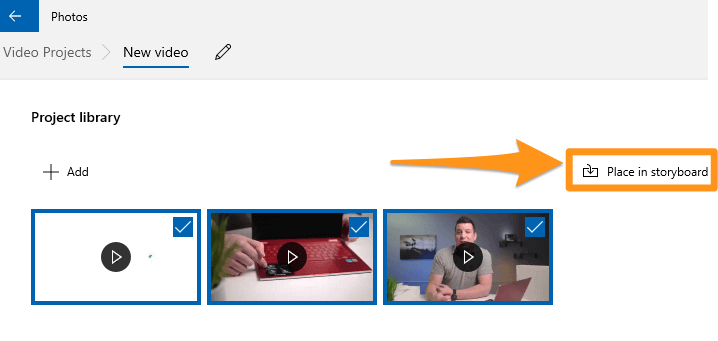
These are the steps to combine multiple clips in Windows 10 with Photos App.
Step 1: Open Photos App
Go to the ‘Start’ menu, find Photos App, and click to open it.
Step 2: Make a New Project
Click the ‘New video project’ (big blue box) under the ‘Video Projects’ tab. Alternatively, you can click the ‘New video’ button and select the ‘New video project’ option from the dropdown menu.
Step 3: Add Clips
Look for the text ‘Project library.’ Then click the ‘+ Add’ button. This will open a new window so you can select the clips you want to combine. Also, import videos one by one in a proper sequence because you cannot arrange them later.
Step 4: Make a Storyboard
After importing all the shots, you want to merge, click the ‘Place in storyboard’ button. This option will add all the chosen clips to your project’s storyboard.
- Fastreel by Movavi
Fastreel is a free online video editor. It is extremely easy to use right away, without installing anything. So, on Fastreel, one can edit videos or use online templates in the browser itself. Actually, the first tool we see in the list of Fastreel tools is to merge a video; then, it can be used in order to compress, make, cut, and create a video. On fastreel, you can add a watermark to a video, if wanted - so, it is very voluntary. As for the merging of a video, when this tool is chosen, it’s pretty simple to understand the steps – you can just drop/add multiple files right away.

The format must be either of the listed: MP4, MOV, MKV, AVI, and WMV, and the total size mustn’t exceed 500 MB. Then, in order to add some transitions, a style can be chosen from the drop-down menu, and after that, you should hit on Continue button to stitch the videos together. For the last step, you can export the result by selecting Download option.
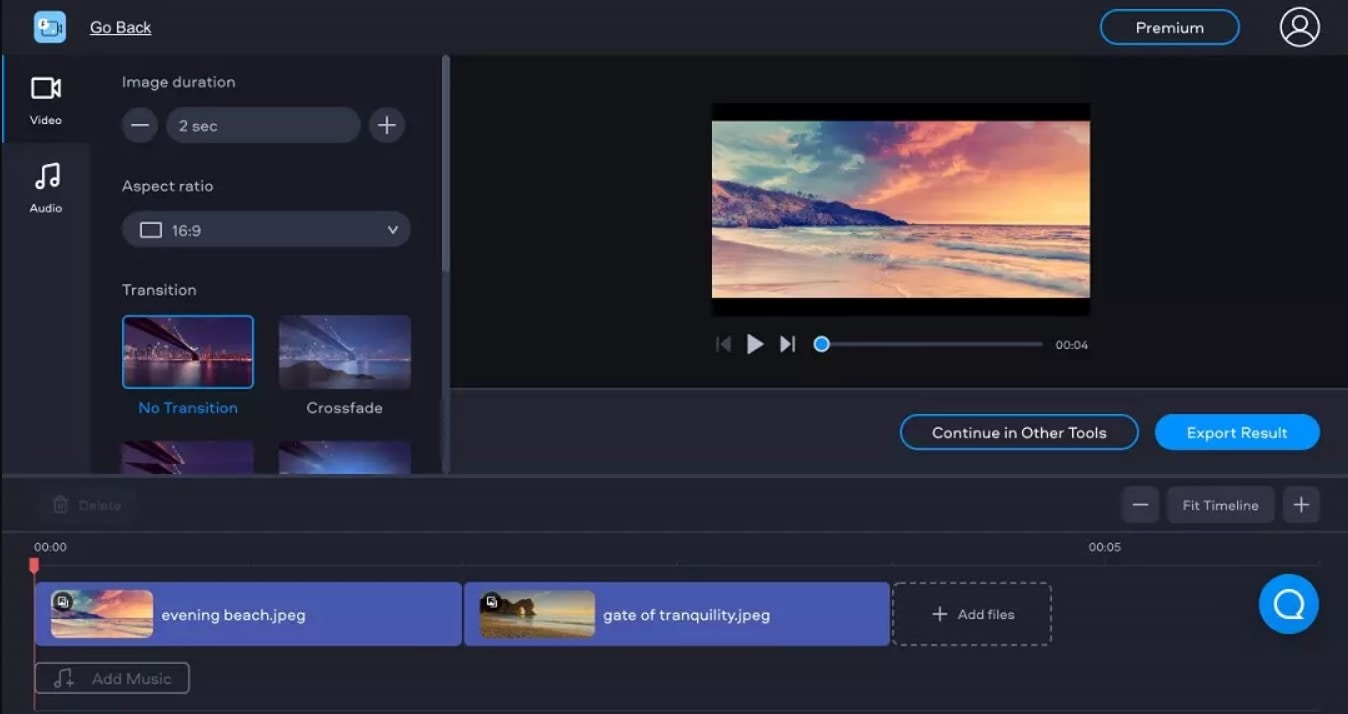
- Free Video Cutter Joiner
Free Video Cutter Joiner – the name already explains it all by itself! This is a free video merger which will not add watermark on your video. The software needs to be downloaded, and contributes to quickly cutting and joining videos. Free Video Cutter Joiner has no size limits – it can cut and merge videos with large file sizes without any trouble, and speed of it to do so is quite fast. It supports several file formats, such as AVI, MPEG, WMV, 3GP FLV, MP4, WMV, MOV, VOB, etc.
So, once downloaded, you will see how user-friendly and straightforward the software is: it shows two of its features right away – video cutter and video joiner. You choose which one you are about to use – so, in our case, video joiner.
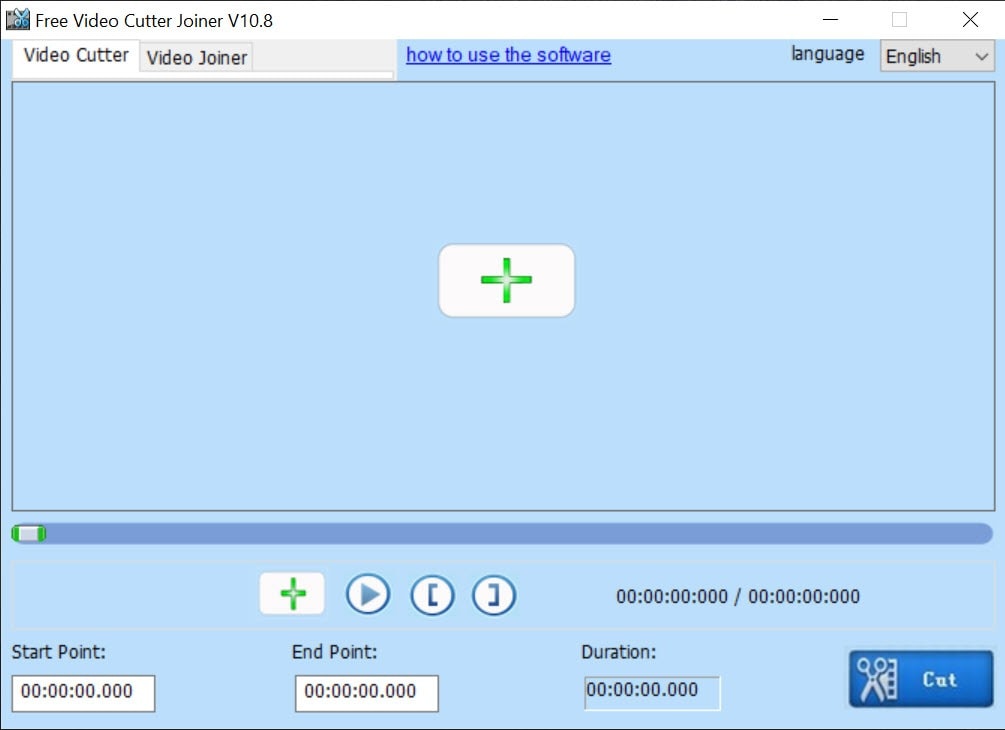
Then, you should click the the “+” icon, which lets you add files from your PC.

Then, hit on the Join button, and choose Indirect Join. Hitting on Start Join will start merging all the uploaded videos, and, wait a little until the process has been completed.
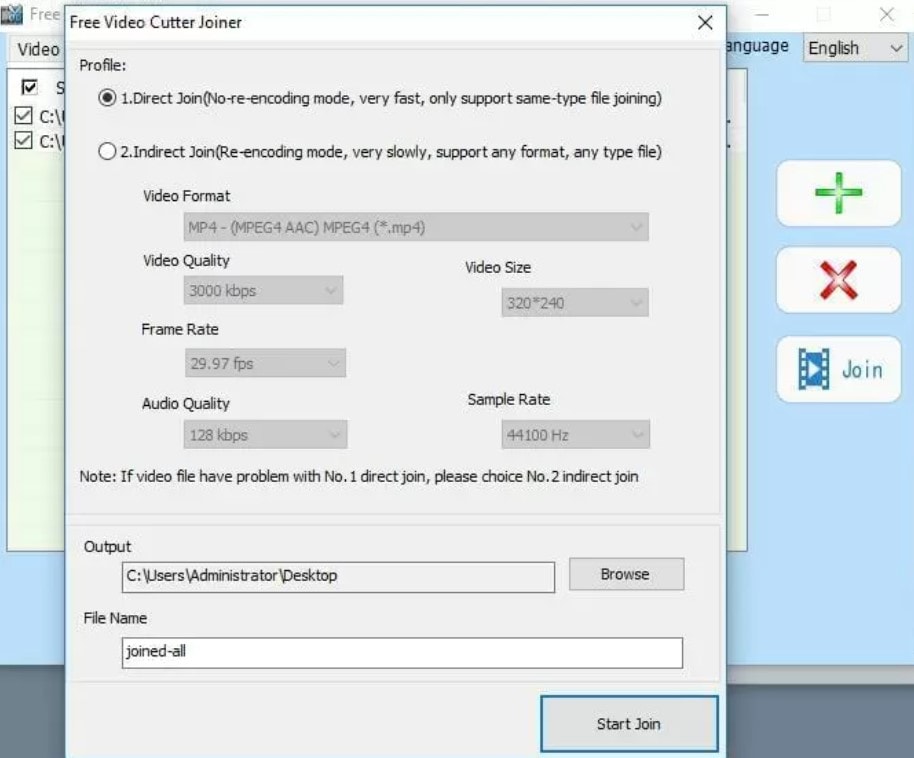
- Clideo
Clideo is the online platform that declares that it makes it super easy to edit all your video files, images and GIFs, and is totally free. It gives us the opportunities to: merge, compress, resize, cut, make, crop, speed, rotate, add music to, loop, flip, reverse, mute, filter, and adjust the videos. Add subtitles, make memes, create slideshows, etc. Therefore, it’s pretty rich in its tools and features.
As for merging videos, much like Fastreel, Clideo is pretty straightforward. You just click on the mentioned tool, and then easily choose files you would like to combine – you can merge any amount of video clips there. Several files can be chosen at the same time, or they can be added one by one.
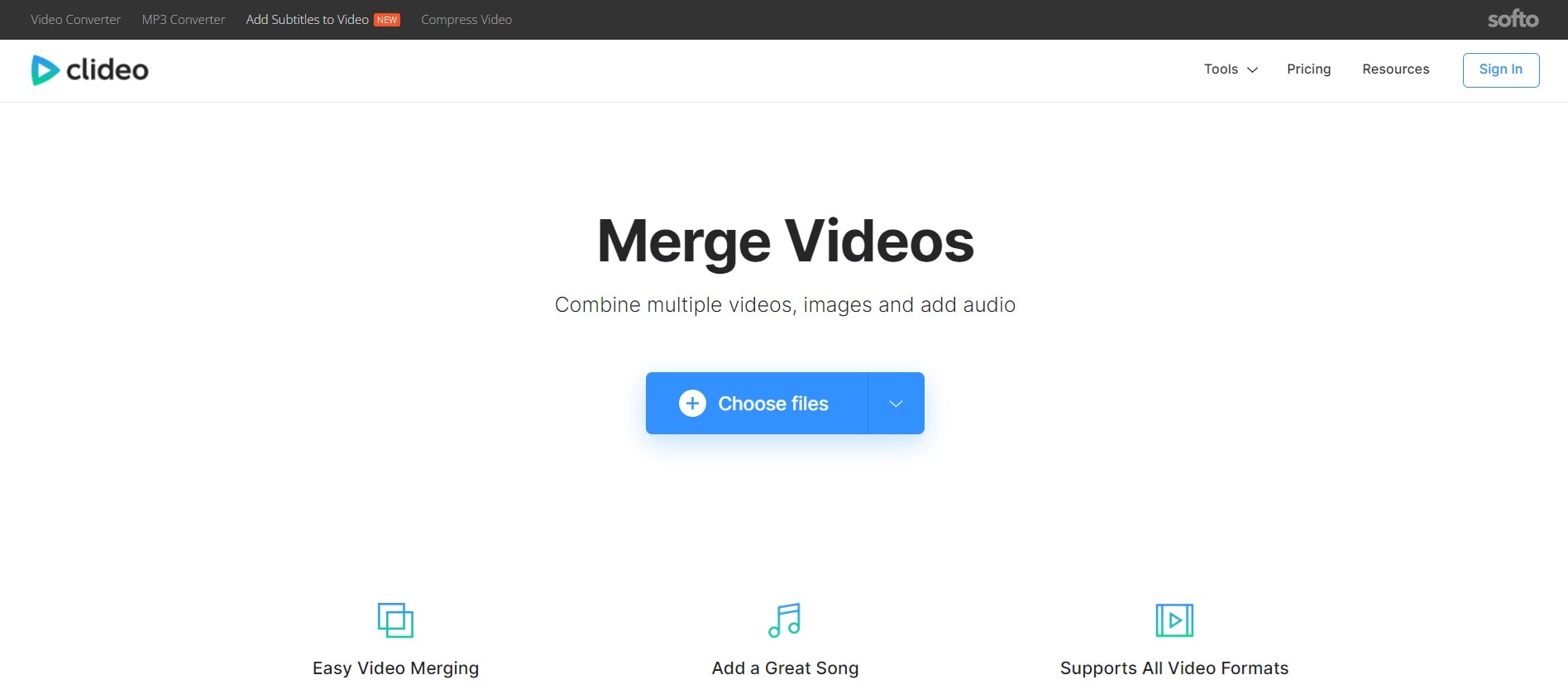
Then it will take you to the editor, where you can join the videos. It’s possible to rearrange the files, by using drag-and-drop until they’re in the desired order. You can also add images and set duration from them, add audio, change its length and volume. The last step is choosing the aspect ratio and clicking the Export button. You can watch the preview of your result and then click on Download if you are satisfied with the merged file.
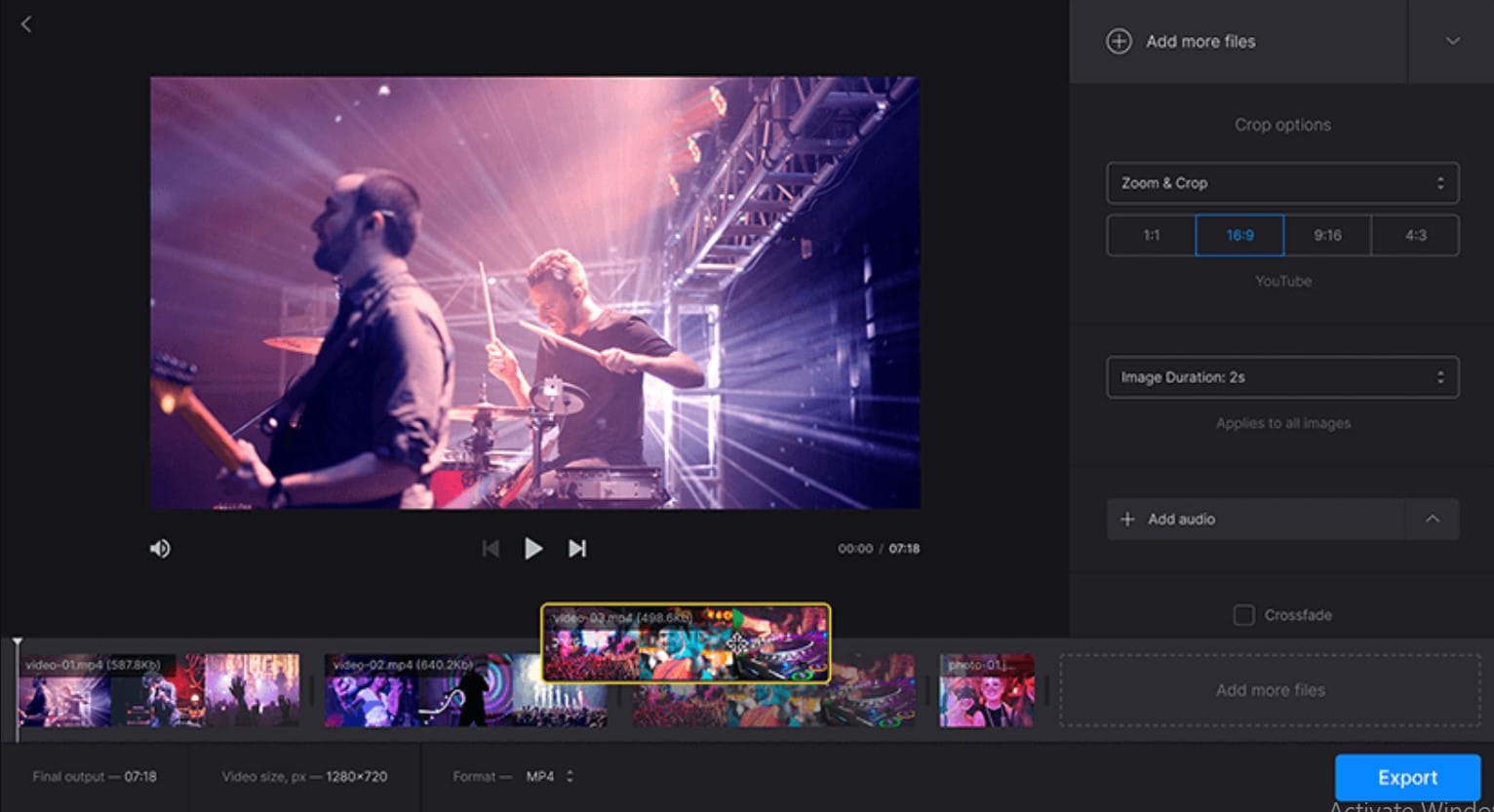
- Typito
Typito is a platform to merge videos online, as well as Fastreel and Clideo. It is free, and mostly aims to create combinations one can use to post on social network such as Instagram, Facebook, and Youtube. Typito supports a great many formats, some of them being MP4, AVI, FLV and WMV. You can edit your videos before merging them by trimming, cropping and resizing, and also add transition effects and music. It quickly combines footage, doesn’t watermark the videos, has brand kit of colors, fonts and style. It can also create collection of images, which is used for making Youtube compilation at most times.
To merge videos, you should choose the tool, then Get Started, and register and sign in first.
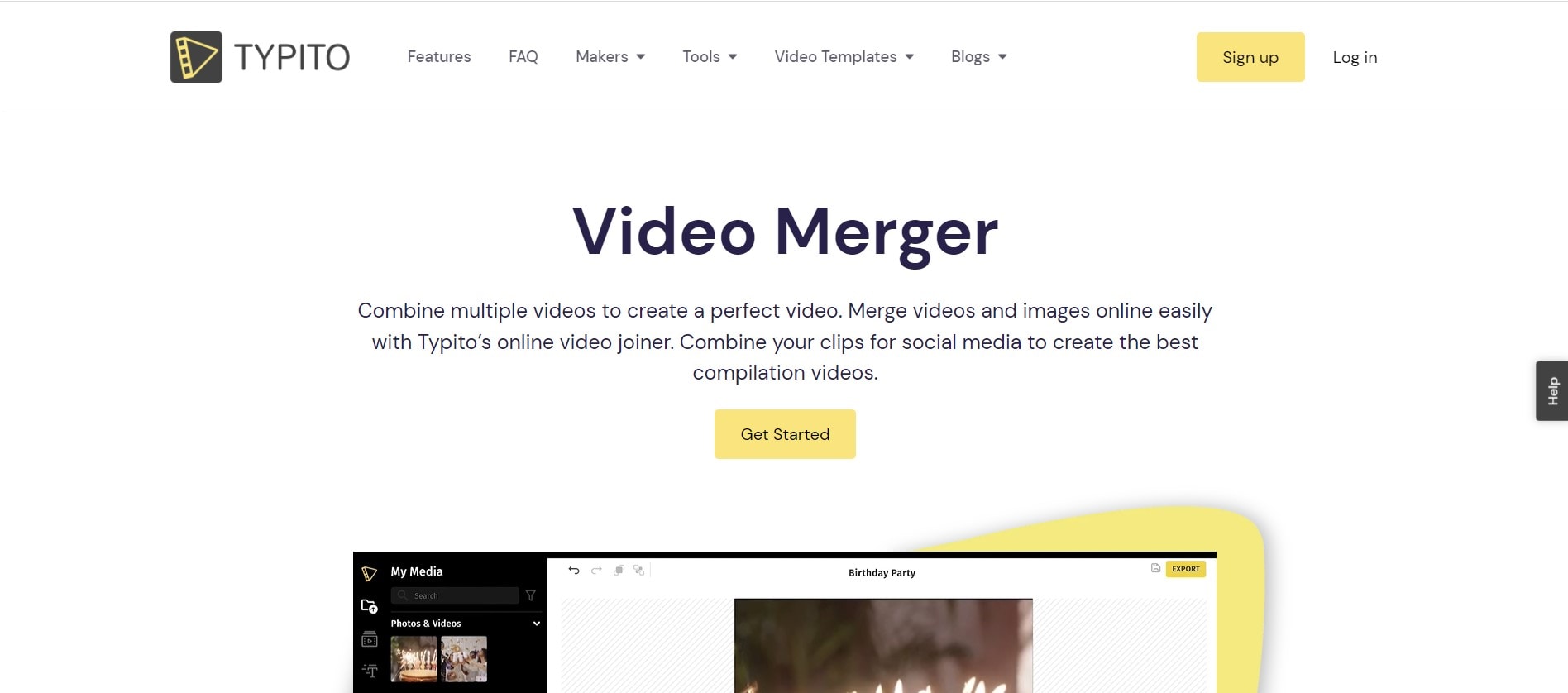
Then click on New Project, choose a video format (the platform offers you the list of the most popular ones), and it will take you to the editor, where you start off by adding media.
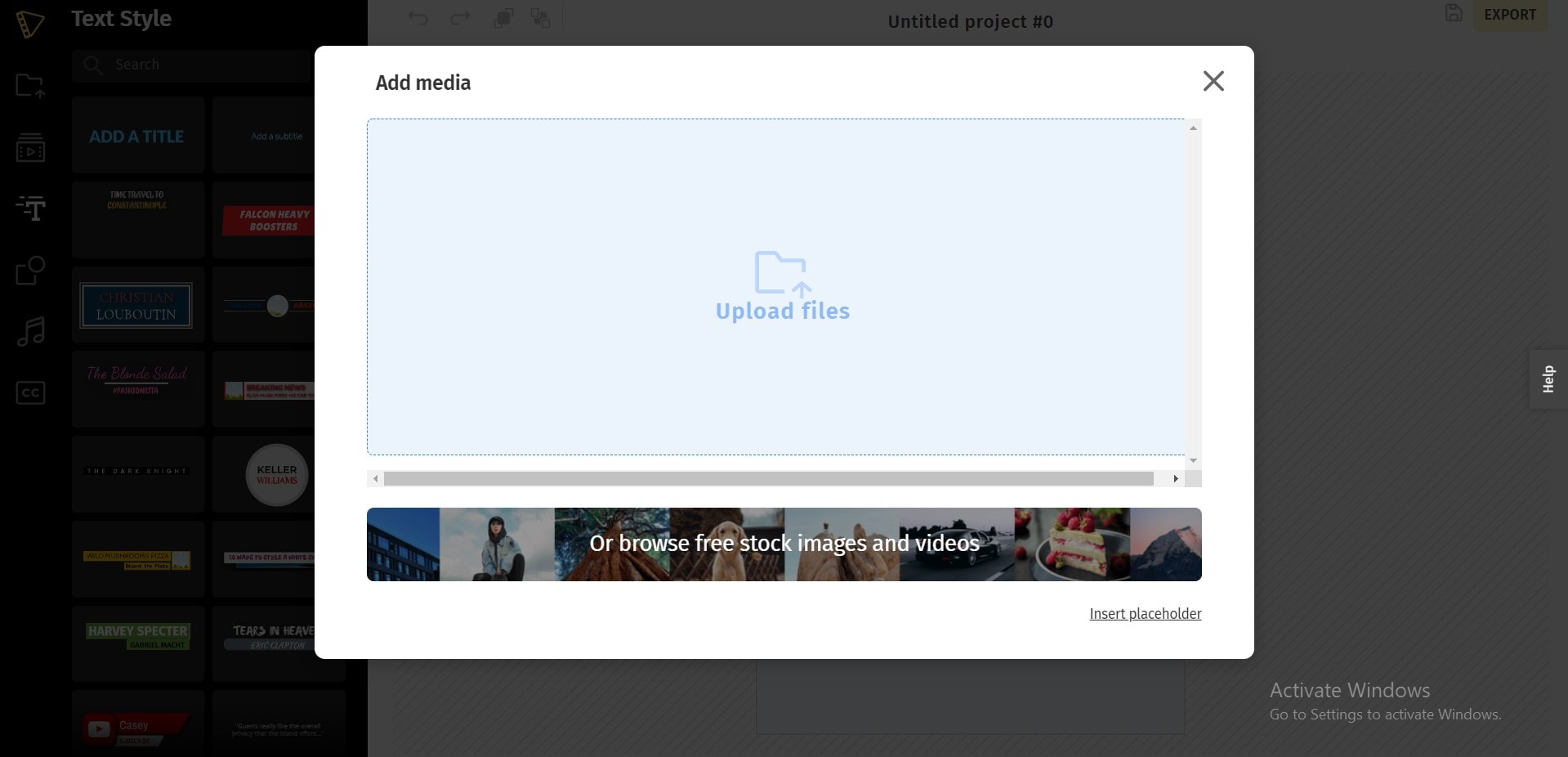
Drag and drop images or videos that you want to combine into a single video. You can also click to upload media files from your system or browse our Stock Media library for high-quality stock photos and video. Then, you can put your video clips in order, and work on it, if you want to use different tools, such as: edit, crop, trim, or resize them, as well as add text captions, images, and transitions. After you have previewed your video, you can click on the export button in the top right corner, and then, your merged video will be ready to be shared.
- Online UniConverter
Online UniConverter is the next online platform giving us the chance to merge our videos without watermark. It is an online analogue of Wondershare UniConverter, and is a very powerful platform, where you can trim, split, rotate, adjust, and download videos in HD quality. UniConverter supports numerous video formats, including MP4, AVI, MOV, MP3, WEBM. Online UniConverter offers various transitions and aspect ratios to fit the screen.
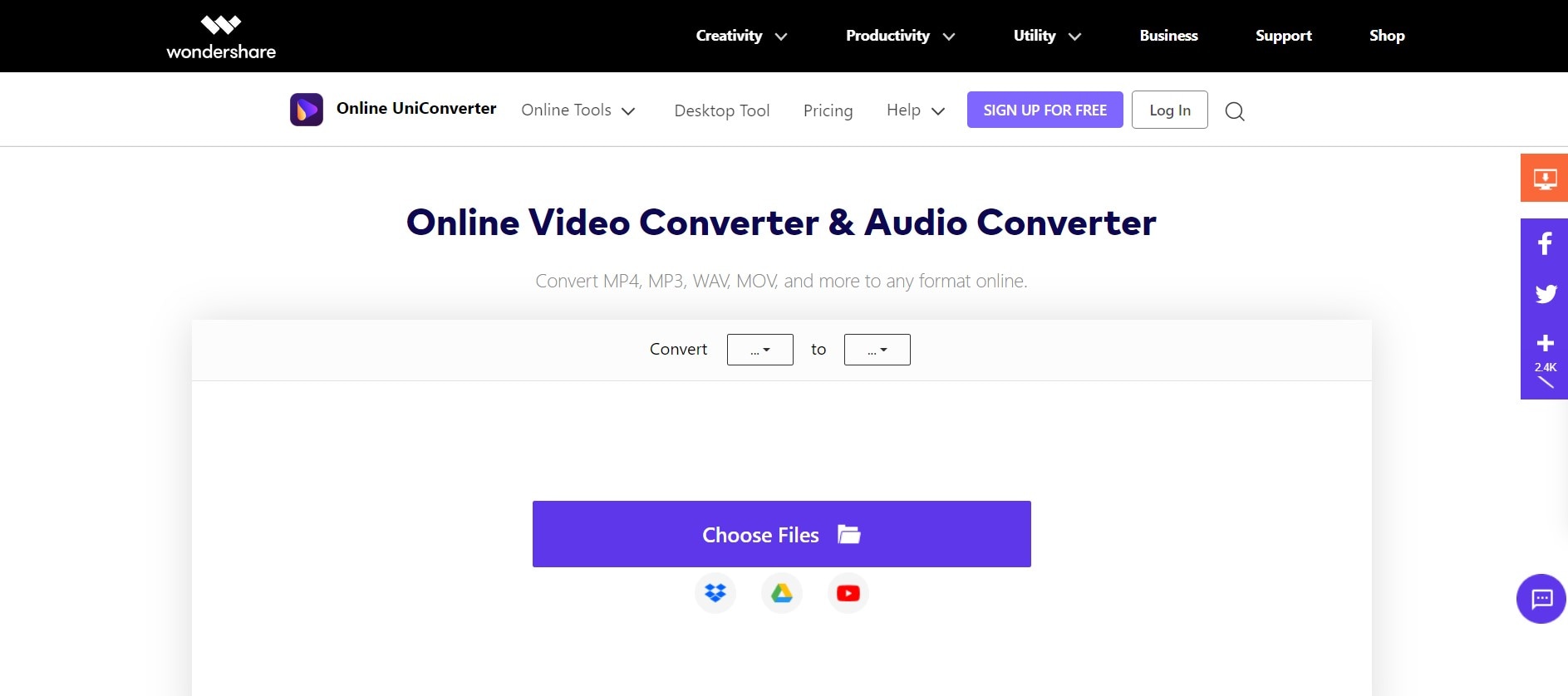
The web-site has lots of tools and features to offer: in the description of it, it reads: video converter, video compressor, video editor, audio converter, audio compressor, audio cutter, GIF maker, YouTube thumbnail, and image resizer. Importing media to the online UniConverter is extremely easy, and combining videos turns out to be a quick process, too.
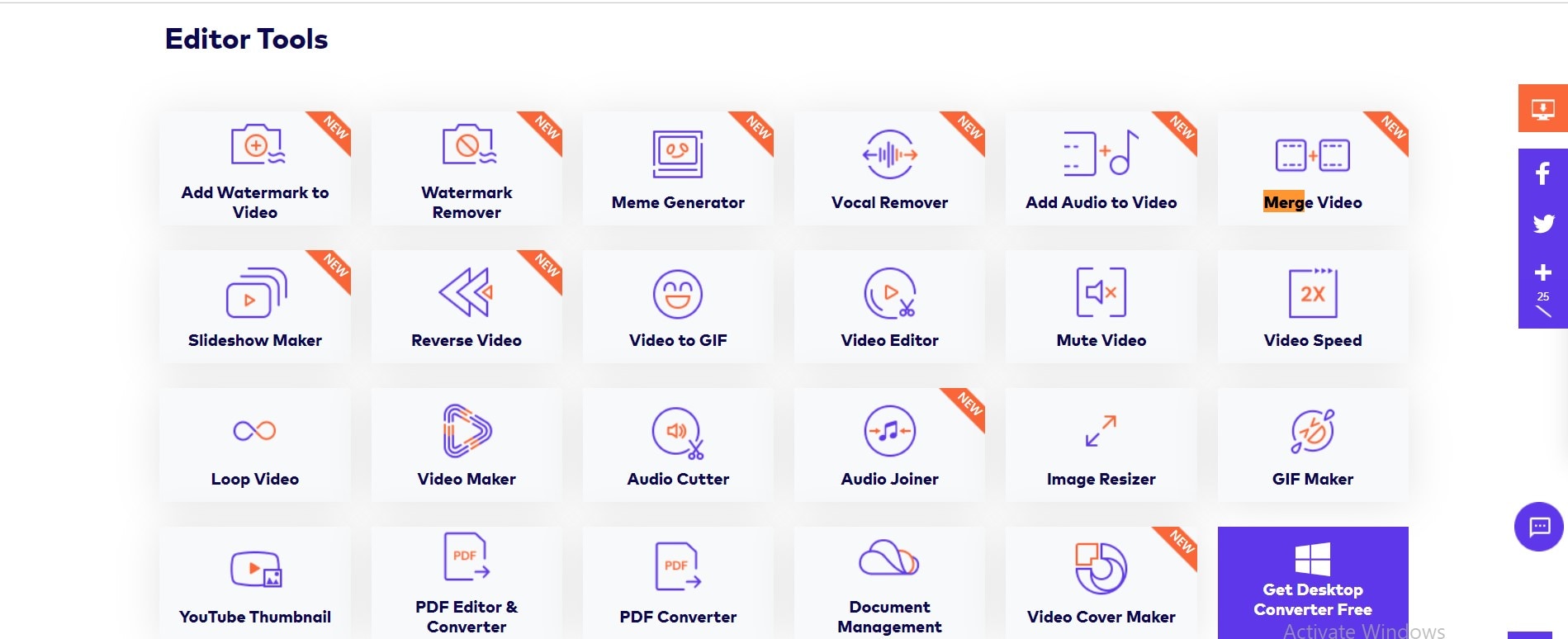
Anyway, if you want to combine a lot of files and the size of them all exceeds 100 MB, you will not be able to use Online Uniconverter for that. It supports the video no more than 100 MB and suggests using Wondershare UniConverter (originally Wondershare Video Converter Ultimate) for Desktop.
- Wondershare Filmora
Last but not least – Filmora Video Editor ! Even it differs from other abovementioned video mergers, as in it is not totally free and adds a Filmora logo on exported project, it’s a great suggestion for people who want to make their videos look great with the help of various tools. When a user is ready to pay, Filmora offers a subscription model, and for a bit more, one can get a permanent license. The software costs $51.99 per year or $79.99 for an outright purchase (prices are regularly discounted).
Wondershare Filmora has a clear and pleasing interface, offers trimming, transitions, overlays, several effects, as well as some more advanced and modern features, such as motion tracking. For this one particular software, we will be offering a step by step guide about how to merge videos there.
For Win 7 or later (64-bit)
For macOS 10.14 or later
- Open the program.
- Choose Import Media Files Here.

- Choose your
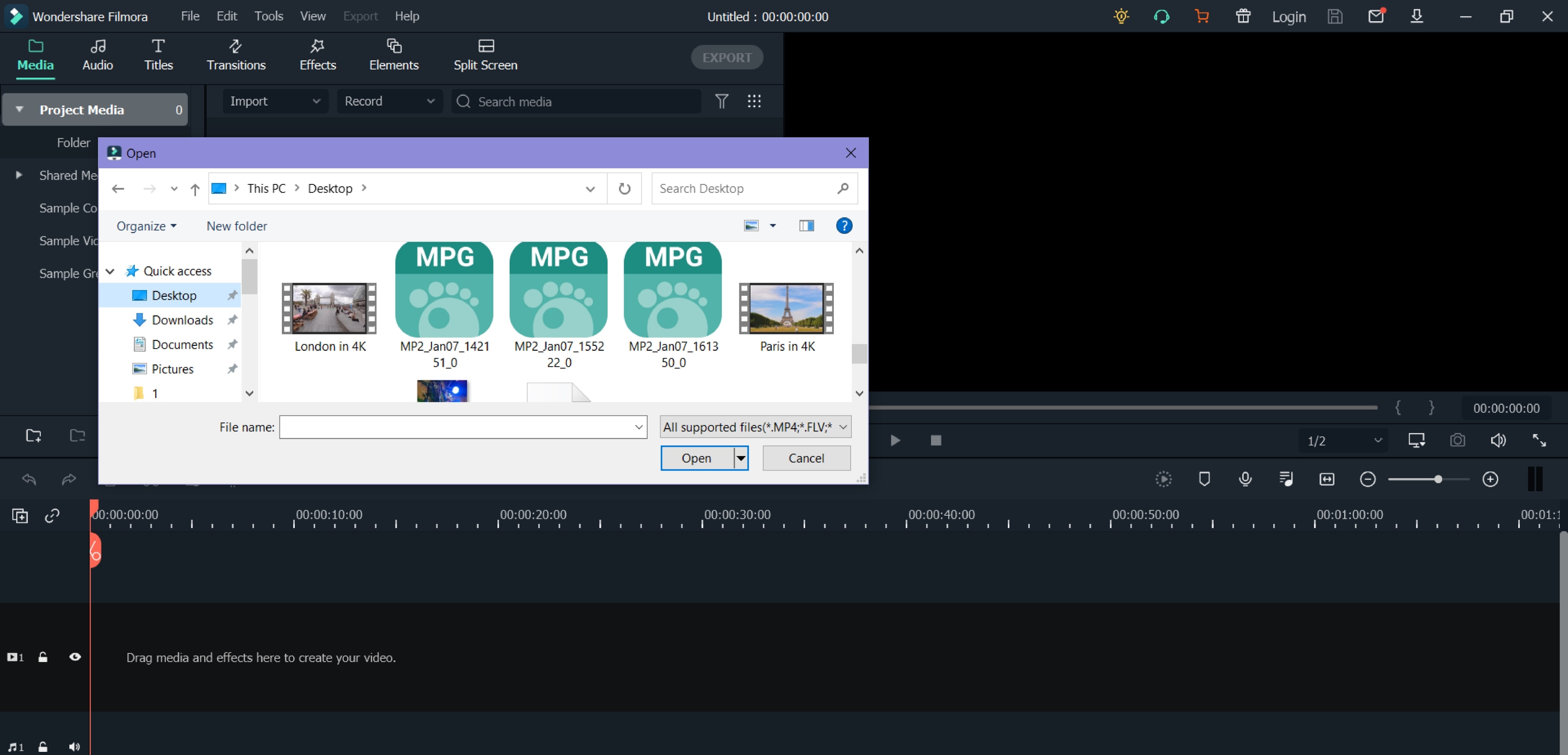
- We can click and drag, essentially, “insert” a video in a sequence below. The Linear Timeline allows us to understand exactly when a video clip ends and when a new one starts.

- Accordingly, we can make one video “sit” next to another. If we want or need it, we will add the third video clip, fourth, and so on.
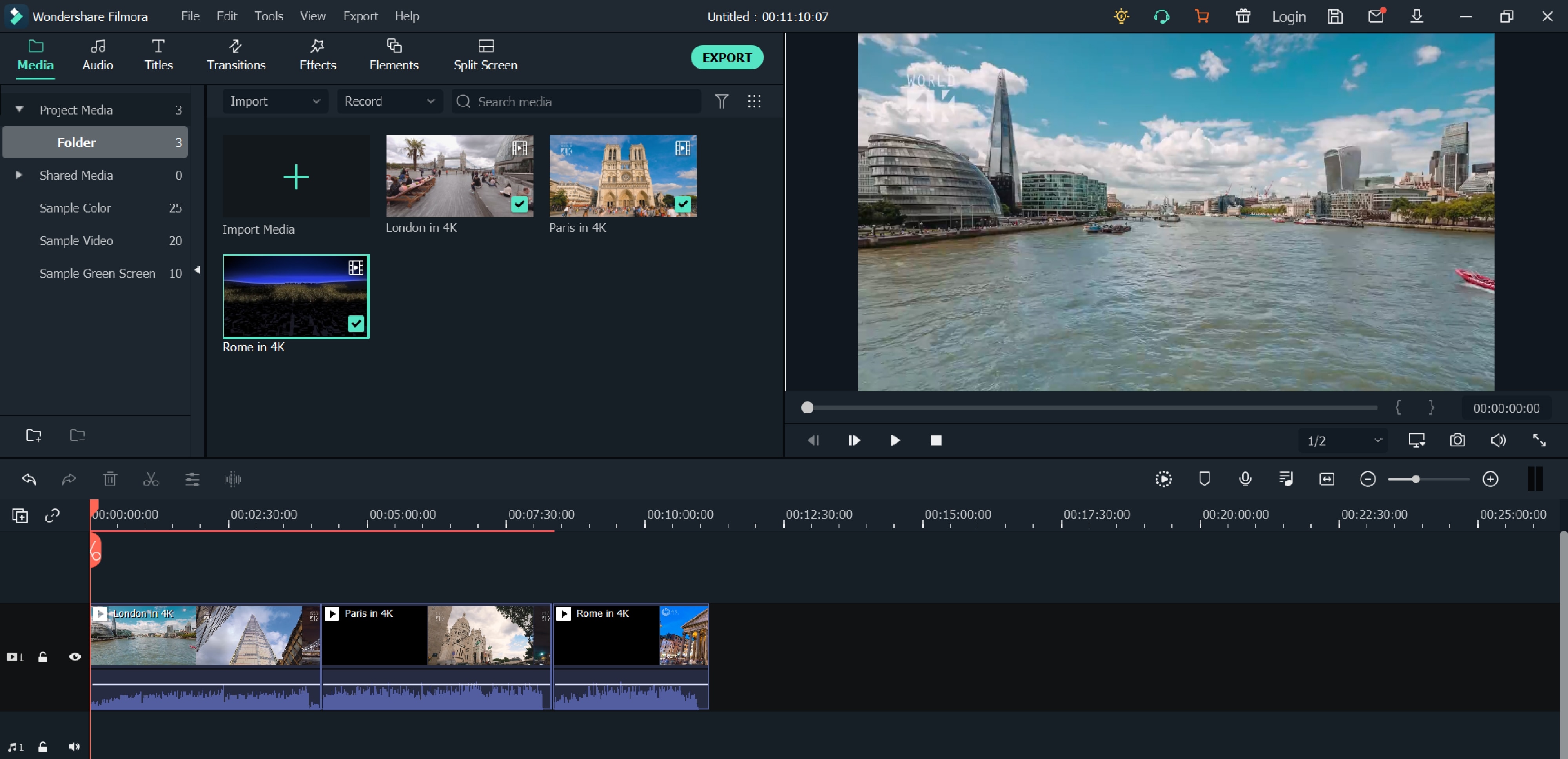
- We can view the entire video and save the video afterwards.
- Start to save video - we make sure the result is exactly what we wanted, find the Export button above the timeline and click on it.
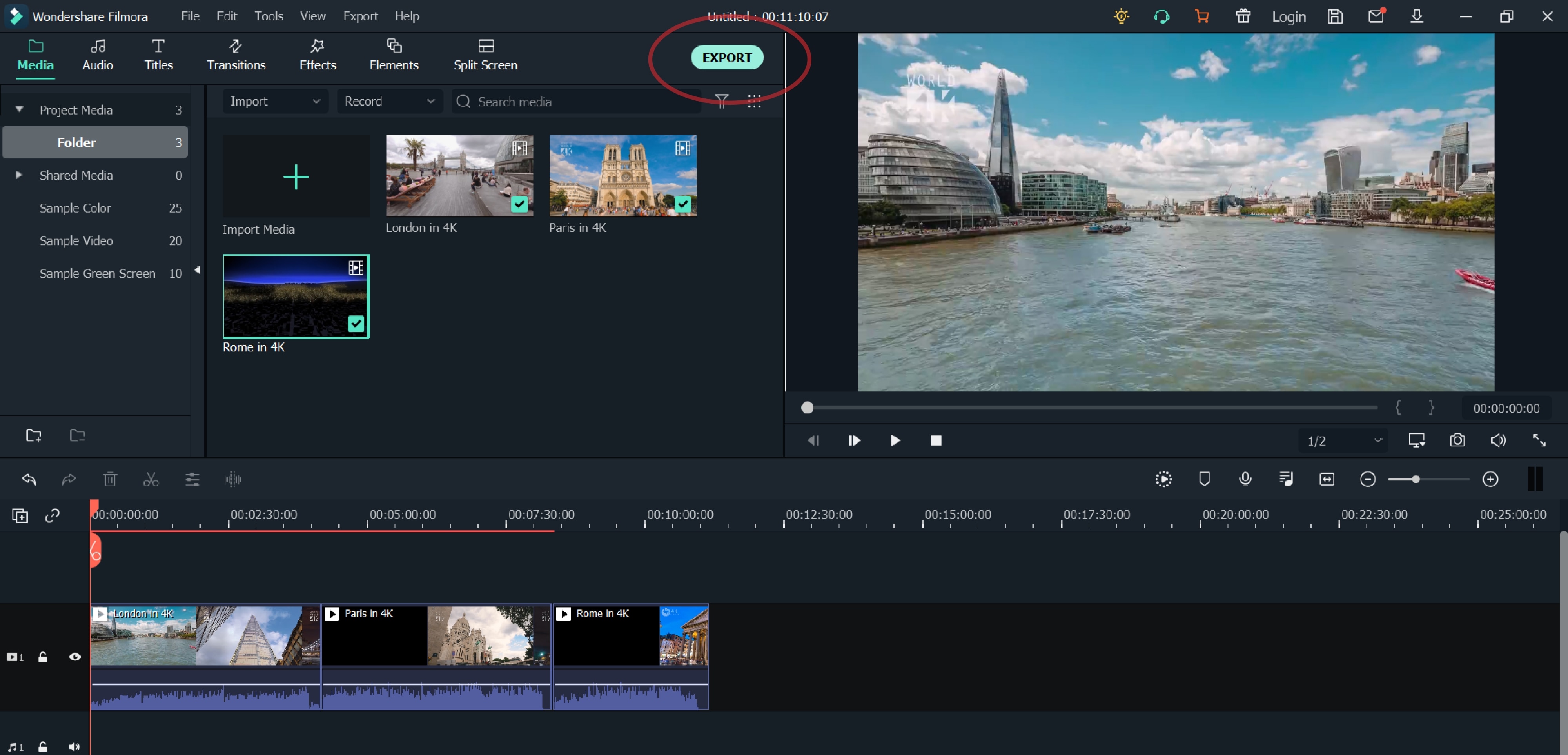
- In the opened window, on the left side, to be precise, if we observe well, we can already choose in which format we want to save our clip. On the right we can indicate what name we want to give to our video; The location where we want to store it; Also, we see the resolution (which we can modify freely after clicking on Settings); Size; Duration.
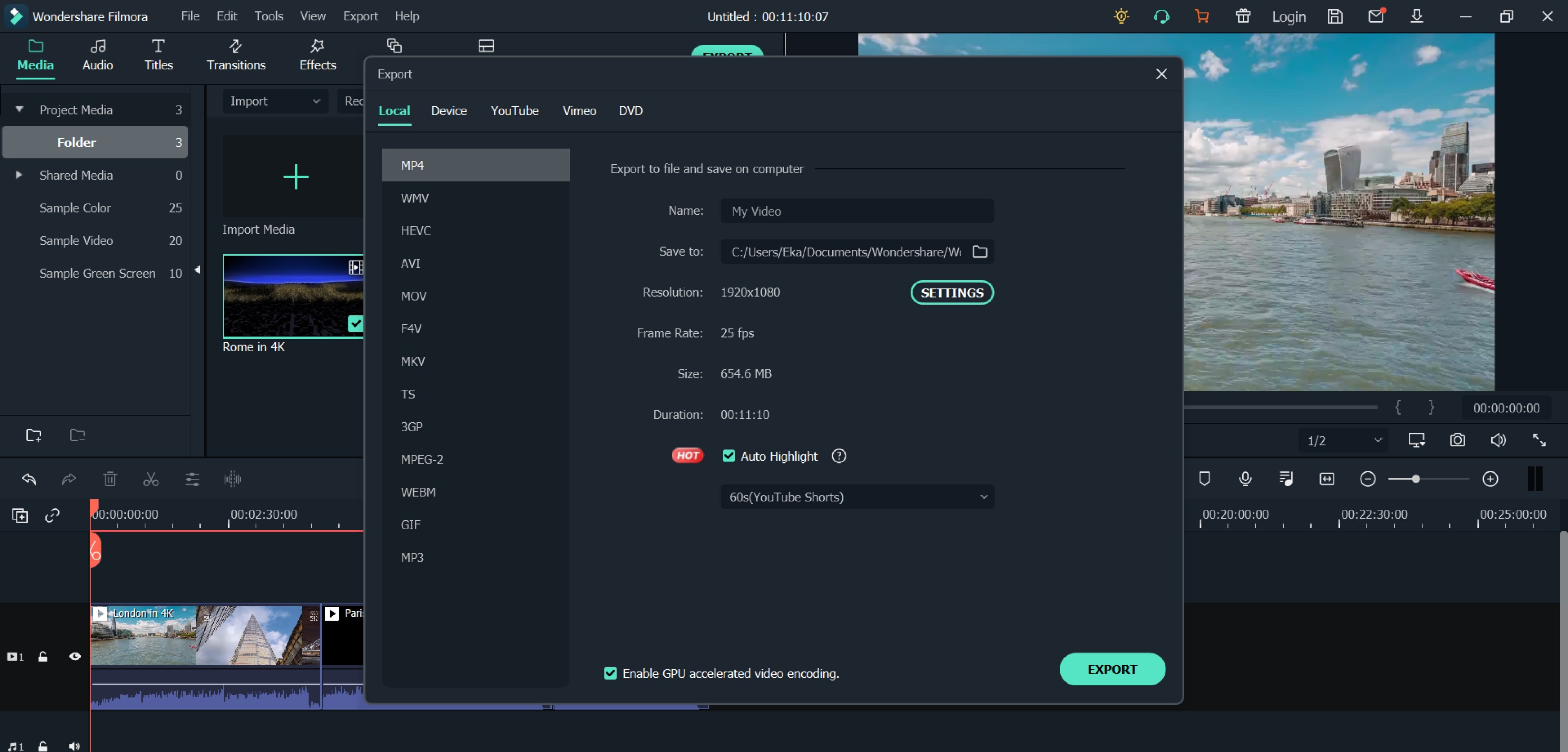
- In Settings, we can decide how much quality the video should have, how many kbps will be the Bit Rate, how many fps the Frame Rate should be, etc., but most likely, beginners will not need to change all this.
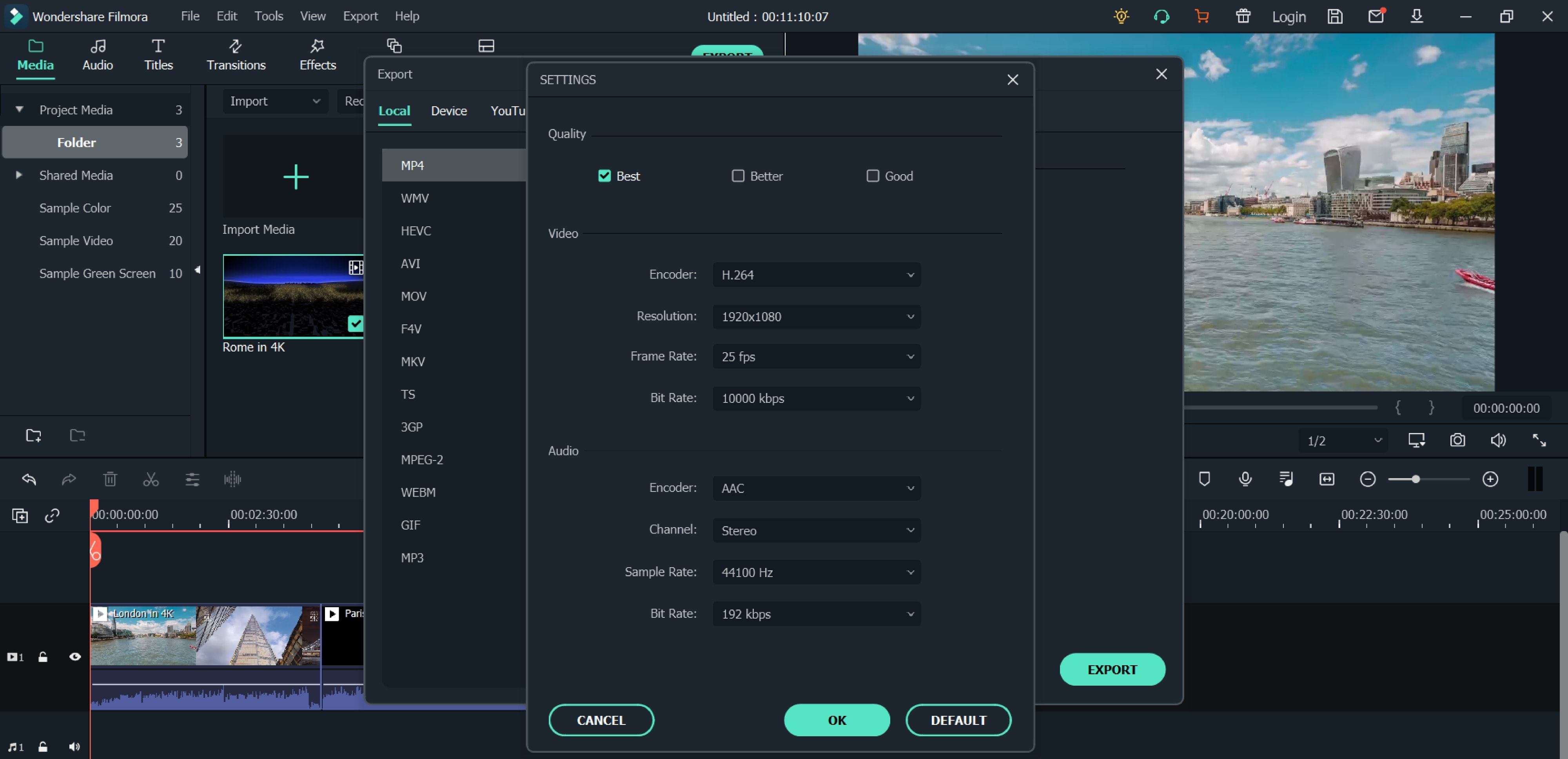
- After selecting everything, right-click on the Export button in the lower right corner of the window and the program will start saving the material.
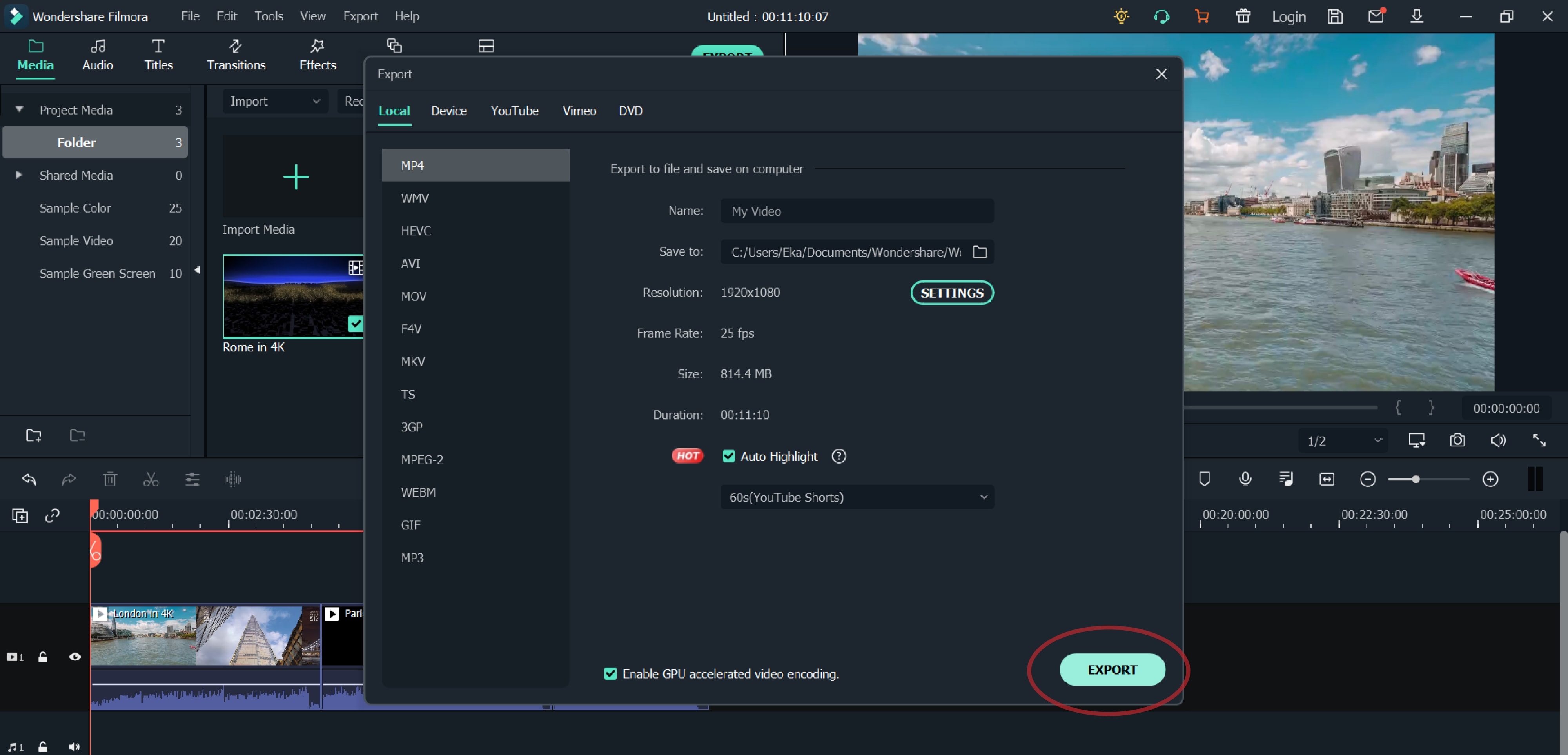

So, in this article, we introduced some online platforms and software for you to use if you would like to merge videos and combine them into one. These are: Fastreel, Free Video Cutter Joiner, Clideo, Typito, Online UniConverter, Wondershare Filmora. It’s up to you which one you would like to choose to merge your videos or edit them in any other way, but you can try either of them and choose to your own liking – even so, of course, there are some other video mergers worth considering, that we might mention in the coming articles. Before then, enjoy with free video editors, without watermark!
If you are too lazy to get high-quality results using popular video editors, like Filmora, try Photos App. It is a built-in program that usually opens your images on Windows 10, but you can also use it for merging your videos. And guess what? Since it comes within the system, all the features, although limited, are absolutely free.
How to Merge Videos on Windows using Photos App?

These are the steps to combine multiple clips in Windows 10 with Photos App.
Step 1: Open Photos App
Go to the ‘Start’ menu, find Photos App, and click to open it.
Step 2: Make a New Project
Click the ‘New video project’ (big blue box) under the ‘Video Projects’ tab. Alternatively, you can click the ‘New video’ button and select the ‘New video project’ option from the dropdown menu.
Step 3: Add Clips
Look for the text ‘Project library.’ Then click the ‘+ Add’ button. This will open a new window so you can select the clips you want to combine. Also, import videos one by one in a proper sequence because you cannot arrange them later.
Step 4: Make a Storyboard
After importing all the shots, you want to merge, click the ‘Place in storyboard’ button. This option will add all the chosen clips to your project’s storyboard.
- Fastreel by Movavi
Fastreel is a free online video editor. It is extremely easy to use right away, without installing anything. So, on Fastreel, one can edit videos or use online templates in the browser itself. Actually, the first tool we see in the list of Fastreel tools is to merge a video; then, it can be used in order to compress, make, cut, and create a video. On fastreel, you can add a watermark to a video, if wanted - so, it is very voluntary. As for the merging of a video, when this tool is chosen, it’s pretty simple to understand the steps – you can just drop/add multiple files right away.

The format must be either of the listed: MP4, MOV, MKV, AVI, and WMV, and the total size mustn’t exceed 500 MB. Then, in order to add some transitions, a style can be chosen from the drop-down menu, and after that, you should hit on Continue button to stitch the videos together. For the last step, you can export the result by selecting Download option.

- Free Video Cutter Joiner
Free Video Cutter Joiner – the name already explains it all by itself! This is a free video merger which will not add watermark on your video. The software needs to be downloaded, and contributes to quickly cutting and joining videos. Free Video Cutter Joiner has no size limits – it can cut and merge videos with large file sizes without any trouble, and speed of it to do so is quite fast. It supports several file formats, such as AVI, MPEG, WMV, 3GP FLV, MP4, WMV, MOV, VOB, etc.
So, once downloaded, you will see how user-friendly and straightforward the software is: it shows two of its features right away – video cutter and video joiner. You choose which one you are about to use – so, in our case, video joiner.

Then, you should click the the “+” icon, which lets you add files from your PC.

Then, hit on the Join button, and choose Indirect Join. Hitting on Start Join will start merging all the uploaded videos, and, wait a little until the process has been completed.

- Clideo
Clideo is the online platform that declares that it makes it super easy to edit all your video files, images and GIFs, and is totally free. It gives us the opportunities to: merge, compress, resize, cut, make, crop, speed, rotate, add music to, loop, flip, reverse, mute, filter, and adjust the videos. Add subtitles, make memes, create slideshows, etc. Therefore, it’s pretty rich in its tools and features.
As for merging videos, much like Fastreel, Clideo is pretty straightforward. You just click on the mentioned tool, and then easily choose files you would like to combine – you can merge any amount of video clips there. Several files can be chosen at the same time, or they can be added one by one.

Then it will take you to the editor, where you can join the videos. It’s possible to rearrange the files, by using drag-and-drop until they’re in the desired order. You can also add images and set duration from them, add audio, change its length and volume. The last step is choosing the aspect ratio and clicking the Export button. You can watch the preview of your result and then click on Download if you are satisfied with the merged file.

- Typito
Typito is a platform to merge videos online, as well as Fastreel and Clideo. It is free, and mostly aims to create combinations one can use to post on social network such as Instagram, Facebook, and Youtube. Typito supports a great many formats, some of them being MP4, AVI, FLV and WMV. You can edit your videos before merging them by trimming, cropping and resizing, and also add transition effects and music. It quickly combines footage, doesn’t watermark the videos, has brand kit of colors, fonts and style. It can also create collection of images, which is used for making Youtube compilation at most times.
To merge videos, you should choose the tool, then Get Started, and register and sign in first.

Then click on New Project, choose a video format (the platform offers you the list of the most popular ones), and it will take you to the editor, where you start off by adding media.

Drag and drop images or videos that you want to combine into a single video. You can also click to upload media files from your system or browse our Stock Media library for high-quality stock photos and video. Then, you can put your video clips in order, and work on it, if you want to use different tools, such as: edit, crop, trim, or resize them, as well as add text captions, images, and transitions. After you have previewed your video, you can click on the export button in the top right corner, and then, your merged video will be ready to be shared.
- Online UniConverter
Online UniConverter is the next online platform giving us the chance to merge our videos without watermark. It is an online analogue of Wondershare UniConverter, and is a very powerful platform, where you can trim, split, rotate, adjust, and download videos in HD quality. UniConverter supports numerous video formats, including MP4, AVI, MOV, MP3, WEBM. Online UniConverter offers various transitions and aspect ratios to fit the screen.

The web-site has lots of tools and features to offer: in the description of it, it reads: video converter, video compressor, video editor, audio converter, audio compressor, audio cutter, GIF maker, YouTube thumbnail, and image resizer. Importing media to the online UniConverter is extremely easy, and combining videos turns out to be a quick process, too.

Anyway, if you want to combine a lot of files and the size of them all exceeds 100 MB, you will not be able to use Online Uniconverter for that. It supports the video no more than 100 MB and suggests using Wondershare UniConverter (originally Wondershare Video Converter Ultimate) for Desktop.
- Wondershare Filmora
Last but not least – Filmora Video Editor ! Even it differs from other abovementioned video mergers, as in it is not totally free and adds a Filmora logo on exported project, it’s a great suggestion for people who want to make their videos look great with the help of various tools. When a user is ready to pay, Filmora offers a subscription model, and for a bit more, one can get a permanent license. The software costs $51.99 per year or $79.99 for an outright purchase (prices are regularly discounted).
Wondershare Filmora has a clear and pleasing interface, offers trimming, transitions, overlays, several effects, as well as some more advanced and modern features, such as motion tracking. For this one particular software, we will be offering a step by step guide about how to merge videos there.
For Win 7 or later (64-bit)
For macOS 10.14 or later
- Open the program.
- Choose Import Media Files Here.

- Choose your

- We can click and drag, essentially, “insert” a video in a sequence below. The Linear Timeline allows us to understand exactly when a video clip ends and when a new one starts.

- Accordingly, we can make one video “sit” next to another. If we want or need it, we will add the third video clip, fourth, and so on.

- We can view the entire video and save the video afterwards.
- Start to save video - we make sure the result is exactly what we wanted, find the Export button above the timeline and click on it.

- In the opened window, on the left side, to be precise, if we observe well, we can already choose in which format we want to save our clip. On the right we can indicate what name we want to give to our video; The location where we want to store it; Also, we see the resolution (which we can modify freely after clicking on Settings); Size; Duration.

- In Settings, we can decide how much quality the video should have, how many kbps will be the Bit Rate, how many fps the Frame Rate should be, etc., but most likely, beginners will not need to change all this.

- After selecting everything, right-click on the Export button in the lower right corner of the window and the program will start saving the material.


So, in this article, we introduced some online platforms and software for you to use if you would like to merge videos and combine them into one. These are: Fastreel, Free Video Cutter Joiner, Clideo, Typito, Online UniConverter, Wondershare Filmora. It’s up to you which one you would like to choose to merge your videos or edit them in any other way, but you can try either of them and choose to your own liking – even so, of course, there are some other video mergers worth considering, that we might mention in the coming articles. Before then, enjoy with free video editors, without watermark!
If you are too lazy to get high-quality results using popular video editors, like Filmora, try Photos App. It is a built-in program that usually opens your images on Windows 10, but you can also use it for merging your videos. And guess what? Since it comes within the system, all the features, although limited, are absolutely free.
How to Merge Videos on Windows using Photos App?

These are the steps to combine multiple clips in Windows 10 with Photos App.
Step 1: Open Photos App
Go to the ‘Start’ menu, find Photos App, and click to open it.
Step 2: Make a New Project
Click the ‘New video project’ (big blue box) under the ‘Video Projects’ tab. Alternatively, you can click the ‘New video’ button and select the ‘New video project’ option from the dropdown menu.
Step 3: Add Clips
Look for the text ‘Project library.’ Then click the ‘+ Add’ button. This will open a new window so you can select the clips you want to combine. Also, import videos one by one in a proper sequence because you cannot arrange them later.
Step 4: Make a Storyboard
After importing all the shots, you want to merge, click the ‘Place in storyboard’ button. This option will add all the chosen clips to your project’s storyboard.
- Fastreel by Movavi
Fastreel is a free online video editor. It is extremely easy to use right away, without installing anything. So, on Fastreel, one can edit videos or use online templates in the browser itself. Actually, the first tool we see in the list of Fastreel tools is to merge a video; then, it can be used in order to compress, make, cut, and create a video. On fastreel, you can add a watermark to a video, if wanted - so, it is very voluntary. As for the merging of a video, when this tool is chosen, it’s pretty simple to understand the steps – you can just drop/add multiple files right away.

The format must be either of the listed: MP4, MOV, MKV, AVI, and WMV, and the total size mustn’t exceed 500 MB. Then, in order to add some transitions, a style can be chosen from the drop-down menu, and after that, you should hit on Continue button to stitch the videos together. For the last step, you can export the result by selecting Download option.

- Free Video Cutter Joiner
Free Video Cutter Joiner – the name already explains it all by itself! This is a free video merger which will not add watermark on your video. The software needs to be downloaded, and contributes to quickly cutting and joining videos. Free Video Cutter Joiner has no size limits – it can cut and merge videos with large file sizes without any trouble, and speed of it to do so is quite fast. It supports several file formats, such as AVI, MPEG, WMV, 3GP FLV, MP4, WMV, MOV, VOB, etc.
So, once downloaded, you will see how user-friendly and straightforward the software is: it shows two of its features right away – video cutter and video joiner. You choose which one you are about to use – so, in our case, video joiner.

Then, you should click the the “+” icon, which lets you add files from your PC.

Then, hit on the Join button, and choose Indirect Join. Hitting on Start Join will start merging all the uploaded videos, and, wait a little until the process has been completed.

- Clideo
Clideo is the online platform that declares that it makes it super easy to edit all your video files, images and GIFs, and is totally free. It gives us the opportunities to: merge, compress, resize, cut, make, crop, speed, rotate, add music to, loop, flip, reverse, mute, filter, and adjust the videos. Add subtitles, make memes, create slideshows, etc. Therefore, it’s pretty rich in its tools and features.
As for merging videos, much like Fastreel, Clideo is pretty straightforward. You just click on the mentioned tool, and then easily choose files you would like to combine – you can merge any amount of video clips there. Several files can be chosen at the same time, or they can be added one by one.

Then it will take you to the editor, where you can join the videos. It’s possible to rearrange the files, by using drag-and-drop until they’re in the desired order. You can also add images and set duration from them, add audio, change its length and volume. The last step is choosing the aspect ratio and clicking the Export button. You can watch the preview of your result and then click on Download if you are satisfied with the merged file.

- Typito
Typito is a platform to merge videos online, as well as Fastreel and Clideo. It is free, and mostly aims to create combinations one can use to post on social network such as Instagram, Facebook, and Youtube. Typito supports a great many formats, some of them being MP4, AVI, FLV and WMV. You can edit your videos before merging them by trimming, cropping and resizing, and also add transition effects and music. It quickly combines footage, doesn’t watermark the videos, has brand kit of colors, fonts and style. It can also create collection of images, which is used for making Youtube compilation at most times.
To merge videos, you should choose the tool, then Get Started, and register and sign in first.

Then click on New Project, choose a video format (the platform offers you the list of the most popular ones), and it will take you to the editor, where you start off by adding media.

Drag and drop images or videos that you want to combine into a single video. You can also click to upload media files from your system or browse our Stock Media library for high-quality stock photos and video. Then, you can put your video clips in order, and work on it, if you want to use different tools, such as: edit, crop, trim, or resize them, as well as add text captions, images, and transitions. After you have previewed your video, you can click on the export button in the top right corner, and then, your merged video will be ready to be shared.
- Online UniConverter
Online UniConverter is the next online platform giving us the chance to merge our videos without watermark. It is an online analogue of Wondershare UniConverter, and is a very powerful platform, where you can trim, split, rotate, adjust, and download videos in HD quality. UniConverter supports numerous video formats, including MP4, AVI, MOV, MP3, WEBM. Online UniConverter offers various transitions and aspect ratios to fit the screen.

The web-site has lots of tools and features to offer: in the description of it, it reads: video converter, video compressor, video editor, audio converter, audio compressor, audio cutter, GIF maker, YouTube thumbnail, and image resizer. Importing media to the online UniConverter is extremely easy, and combining videos turns out to be a quick process, too.

Anyway, if you want to combine a lot of files and the size of them all exceeds 100 MB, you will not be able to use Online Uniconverter for that. It supports the video no more than 100 MB and suggests using Wondershare UniConverter (originally Wondershare Video Converter Ultimate) for Desktop.
- Wondershare Filmora
Last but not least – Filmora Video Editor ! Even it differs from other abovementioned video mergers, as in it is not totally free and adds a Filmora logo on exported project, it’s a great suggestion for people who want to make their videos look great with the help of various tools. When a user is ready to pay, Filmora offers a subscription model, and for a bit more, one can get a permanent license. The software costs $51.99 per year or $79.99 for an outright purchase (prices are regularly discounted).
Wondershare Filmora has a clear and pleasing interface, offers trimming, transitions, overlays, several effects, as well as some more advanced and modern features, such as motion tracking. For this one particular software, we will be offering a step by step guide about how to merge videos there.
For Win 7 or later (64-bit)
For macOS 10.14 or later
- Open the program.
- Choose Import Media Files Here.

- Choose your

- We can click and drag, essentially, “insert” a video in a sequence below. The Linear Timeline allows us to understand exactly when a video clip ends and when a new one starts.

- Accordingly, we can make one video “sit” next to another. If we want or need it, we will add the third video clip, fourth, and so on.

- We can view the entire video and save the video afterwards.
- Start to save video - we make sure the result is exactly what we wanted, find the Export button above the timeline and click on it.

- In the opened window, on the left side, to be precise, if we observe well, we can already choose in which format we want to save our clip. On the right we can indicate what name we want to give to our video; The location where we want to store it; Also, we see the resolution (which we can modify freely after clicking on Settings); Size; Duration.

- In Settings, we can decide how much quality the video should have, how many kbps will be the Bit Rate, how many fps the Frame Rate should be, etc., but most likely, beginners will not need to change all this.

- After selecting everything, right-click on the Export button in the lower right corner of the window and the program will start saving the material.


So, in this article, we introduced some online platforms and software for you to use if you would like to merge videos and combine them into one. These are: Fastreel, Free Video Cutter Joiner, Clideo, Typito, Online UniConverter, Wondershare Filmora. It’s up to you which one you would like to choose to merge your videos or edit them in any other way, but you can try either of them and choose to your own liking – even so, of course, there are some other video mergers worth considering, that we might mention in the coming articles. Before then, enjoy with free video editors, without watermark!
If you are too lazy to get high-quality results using popular video editors, like Filmora, try Photos App. It is a built-in program that usually opens your images on Windows 10, but you can also use it for merging your videos. And guess what? Since it comes within the system, all the features, although limited, are absolutely free.
How to Merge Videos on Windows using Photos App?

These are the steps to combine multiple clips in Windows 10 with Photos App.
Step 1: Open Photos App
Go to the ‘Start’ menu, find Photos App, and click to open it.
Step 2: Make a New Project
Click the ‘New video project’ (big blue box) under the ‘Video Projects’ tab. Alternatively, you can click the ‘New video’ button and select the ‘New video project’ option from the dropdown menu.
Step 3: Add Clips
Look for the text ‘Project library.’ Then click the ‘+ Add’ button. This will open a new window so you can select the clips you want to combine. Also, import videos one by one in a proper sequence because you cannot arrange them later.
Step 4: Make a Storyboard
After importing all the shots, you want to merge, click the ‘Place in storyboard’ button. This option will add all the chosen clips to your project’s storyboard.
- Fastreel by Movavi
Fastreel is a free online video editor. It is extremely easy to use right away, without installing anything. So, on Fastreel, one can edit videos or use online templates in the browser itself. Actually, the first tool we see in the list of Fastreel tools is to merge a video; then, it can be used in order to compress, make, cut, and create a video. On fastreel, you can add a watermark to a video, if wanted - so, it is very voluntary. As for the merging of a video, when this tool is chosen, it’s pretty simple to understand the steps – you can just drop/add multiple files right away.

The format must be either of the listed: MP4, MOV, MKV, AVI, and WMV, and the total size mustn’t exceed 500 MB. Then, in order to add some transitions, a style can be chosen from the drop-down menu, and after that, you should hit on Continue button to stitch the videos together. For the last step, you can export the result by selecting Download option.

- Free Video Cutter Joiner
Free Video Cutter Joiner – the name already explains it all by itself! This is a free video merger which will not add watermark on your video. The software needs to be downloaded, and contributes to quickly cutting and joining videos. Free Video Cutter Joiner has no size limits – it can cut and merge videos with large file sizes without any trouble, and speed of it to do so is quite fast. It supports several file formats, such as AVI, MPEG, WMV, 3GP FLV, MP4, WMV, MOV, VOB, etc.
So, once downloaded, you will see how user-friendly and straightforward the software is: it shows two of its features right away – video cutter and video joiner. You choose which one you are about to use – so, in our case, video joiner.

Then, you should click the the “+” icon, which lets you add files from your PC.

Then, hit on the Join button, and choose Indirect Join. Hitting on Start Join will start merging all the uploaded videos, and, wait a little until the process has been completed.

- Clideo
Clideo is the online platform that declares that it makes it super easy to edit all your video files, images and GIFs, and is totally free. It gives us the opportunities to: merge, compress, resize, cut, make, crop, speed, rotate, add music to, loop, flip, reverse, mute, filter, and adjust the videos. Add subtitles, make memes, create slideshows, etc. Therefore, it’s pretty rich in its tools and features.
As for merging videos, much like Fastreel, Clideo is pretty straightforward. You just click on the mentioned tool, and then easily choose files you would like to combine – you can merge any amount of video clips there. Several files can be chosen at the same time, or they can be added one by one.

Then it will take you to the editor, where you can join the videos. It’s possible to rearrange the files, by using drag-and-drop until they’re in the desired order. You can also add images and set duration from them, add audio, change its length and volume. The last step is choosing the aspect ratio and clicking the Export button. You can watch the preview of your result and then click on Download if you are satisfied with the merged file.

- Typito
Typito is a platform to merge videos online, as well as Fastreel and Clideo. It is free, and mostly aims to create combinations one can use to post on social network such as Instagram, Facebook, and Youtube. Typito supports a great many formats, some of them being MP4, AVI, FLV and WMV. You can edit your videos before merging them by trimming, cropping and resizing, and also add transition effects and music. It quickly combines footage, doesn’t watermark the videos, has brand kit of colors, fonts and style. It can also create collection of images, which is used for making Youtube compilation at most times.
To merge videos, you should choose the tool, then Get Started, and register and sign in first.

Then click on New Project, choose a video format (the platform offers you the list of the most popular ones), and it will take you to the editor, where you start off by adding media.

Drag and drop images or videos that you want to combine into a single video. You can also click to upload media files from your system or browse our Stock Media library for high-quality stock photos and video. Then, you can put your video clips in order, and work on it, if you want to use different tools, such as: edit, crop, trim, or resize them, as well as add text captions, images, and transitions. After you have previewed your video, you can click on the export button in the top right corner, and then, your merged video will be ready to be shared.
- Online UniConverter
Online UniConverter is the next online platform giving us the chance to merge our videos without watermark. It is an online analogue of Wondershare UniConverter, and is a very powerful platform, where you can trim, split, rotate, adjust, and download videos in HD quality. UniConverter supports numerous video formats, including MP4, AVI, MOV, MP3, WEBM. Online UniConverter offers various transitions and aspect ratios to fit the screen.

The web-site has lots of tools and features to offer: in the description of it, it reads: video converter, video compressor, video editor, audio converter, audio compressor, audio cutter, GIF maker, YouTube thumbnail, and image resizer. Importing media to the online UniConverter is extremely easy, and combining videos turns out to be a quick process, too.

Anyway, if you want to combine a lot of files and the size of them all exceeds 100 MB, you will not be able to use Online Uniconverter for that. It supports the video no more than 100 MB and suggests using Wondershare UniConverter (originally Wondershare Video Converter Ultimate) for Desktop.
- Wondershare Filmora
Last but not least – Filmora Video Editor ! Even it differs from other abovementioned video mergers, as in it is not totally free and adds a Filmora logo on exported project, it’s a great suggestion for people who want to make their videos look great with the help of various tools. When a user is ready to pay, Filmora offers a subscription model, and for a bit more, one can get a permanent license. The software costs $51.99 per year or $79.99 for an outright purchase (prices are regularly discounted).
Wondershare Filmora has a clear and pleasing interface, offers trimming, transitions, overlays, several effects, as well as some more advanced and modern features, such as motion tracking. For this one particular software, we will be offering a step by step guide about how to merge videos there.
For Win 7 or later (64-bit)
For macOS 10.14 or later
- Open the program.
- Choose Import Media Files Here.

- Choose your

- We can click and drag, essentially, “insert” a video in a sequence below. The Linear Timeline allows us to understand exactly when a video clip ends and when a new one starts.

- Accordingly, we can make one video “sit” next to another. If we want or need it, we will add the third video clip, fourth, and so on.

- We can view the entire video and save the video afterwards.
- Start to save video - we make sure the result is exactly what we wanted, find the Export button above the timeline and click on it.

- In the opened window, on the left side, to be precise, if we observe well, we can already choose in which format we want to save our clip. On the right we can indicate what name we want to give to our video; The location where we want to store it; Also, we see the resolution (which we can modify freely after clicking on Settings); Size; Duration.

- In Settings, we can decide how much quality the video should have, how many kbps will be the Bit Rate, how many fps the Frame Rate should be, etc., but most likely, beginners will not need to change all this.

- After selecting everything, right-click on the Export button in the lower right corner of the window and the program will start saving the material.


So, in this article, we introduced some online platforms and software for you to use if you would like to merge videos and combine them into one. These are: Fastreel, Free Video Cutter Joiner, Clideo, Typito, Online UniConverter, Wondershare Filmora. It’s up to you which one you would like to choose to merge your videos or edit them in any other way, but you can try either of them and choose to your own liking – even so, of course, there are some other video mergers worth considering, that we might mention in the coming articles. Before then, enjoy with free video editors, without watermark!
Vertical Vibes: How to Optimize Your Mobile Video for Maximum Impact
Best Practices for Creating Phone Aspect Ratio Vertical on Your Smartphone
An easy yet powerful editor
Numerous effects to choose from
Detailed tutorials provided by the official channel
When you’re taking a snapshot of someone or something and posting it to social media, you’ll need to decide if it’ll be a portrait or a landscape orientation. And that’s where the knowledge regarding the phone aspect ratio vertical comes in!

This post will dive into the rise of the phone aspect ratio vertical, including best practices on using phone ratio calculator and mobile vertical video size based on its final viewing platforms such as YouTube, Instagram, or broadcast.
In this article
01 [Why Vertical Videos Are in the Frame?](#Part 1)
02 [Different Aspect Ratios on Mobile Screens](#Part 2)
03 [Tips to Shoot a Vertical Video](#Part 3)
04 [Top 6 Practices for Creating Phone Aspect Ratio Vertical on Your Smartphone](#Part 4)
Part 1 Why Vertical Videos Are in the Frame?
Did you know that there are six aspect ratios in total for videos and photos that marketers and creators use? These aspect ratios are 9:16, 16:9, 1:1, 4:3, 3:2, 21:9. The first way to choose the right aspect ratio for your video is whether the video needs to be vertical or horizontal.
A video that’s portrait or vertical mode is taller than it is wide. The entire screen is devoted to vertical video capturing while gaining attention.
Smartphones are to be held vertically, and although you can view media always horizontally, it’s far simpler for watchers to consume media while keeping their mobile phones upright.
Vertical videos are available in different sizes, but the most standard instances come in the 9:16 aspect ratio. While the traditional format of watching videos on phones has been horizontal with an aspect ratio of 16:9, vertical videos are taller than more comprehensive, hence the reversed aspect ratio. And, this is the main reason you see vertical videos in the frame, and thus, they need to be fixed or rightly shot in terms of ideal phone aspect ratio vertical.
Part 2 Different Aspect Ratios on Mobile Screens
The aspect ratio also measures how tall or wide a display is. Still, it shouldn’t be mistaken for ‘display/screen size’ calculated by diagonally measuring throughout the screen.
The phone aspect ratio vertical is commonly written in proportions with the more petite figure on the right side and the more prominent figure on the left-hand side. It’s also sometimes called a decimal, the more prominent figure divided by, the more petite figure.
It means that a display aspect ratio of 16:9 can also be called an aspect ratio of 1.78, i.e., 16/9.
Types of Aspect ratio
● 16:9 Aspect Ratio
16:9 is one of the most common aspect ratios used on smartphones. Sometimes showcased as 1.78 or 4²:3², the aspect ratio has become typical for smartphones and other devices since 2010.
It generally means there will be 16 pixels in one direction for every 9 pixels in the other for a device with a 16:9 display.

Devices with a 16:9 aspect ratio are usually broad, and they became the standard aspect ratio for smartphones because most contents are also available in the exact format. So you would enjoy videos and gaming in full widescreen quality on a 16:9 aspect ratio device.
On the other hand, you’ll experience the “Letterboxing effect“ on devices that aren’t available in 16:9 aspect ratios and where black bars/bands appear at the bottom and the top of the content you are wandering.

● 18:9 Aspect ratio
This 18:9 aspect ratio was born out of the need to maximize the size of displays without increasing the dimensions of phone sizes.
The narrow design of 18:9 aspect ratio devices assisted for better one-hand grip, smooth multitasking, enhanced usability, and more screen real estate, etc. Yet, because contents are highly present in the 16:9 aspect ratio, there will be “black bands” at the top, bottom or to your display’s right or left.

The 18:9 aspect ratio allows for convenient usage of smartphones, provided we put the content-cropping and letterboxing aside.
● 19:9 Aspect ratio
19:9 is another smartphone aspect ratio that is becoming increasingly famous and used by top OEMs like Samsung, Huawei, ASUS, and Apple on their flagship devices.
The smartphones with a 19:9 aspect ratio are available with increased height and 19 pixels in single direction for every 9 pixels in the other. Similar to 18:9, devices with a 19:9 aspect ratio generally have pretty non-existent and slimmer bezels, but you’ll enjoy vast screen real estate with the latter.
Understanding iPhone Vertical Video Dimensions
Apple boasts a 16:9 screen for the versions of iPhone 5 onwards. Most Google/Android phones already had a 16:9 screen at that point. Thus, to export a vertical video, you would want it to be 9:16. (16:9 standing up!) and it’s the ideal size for iPhone vertical video dimensions.
The highest quality vertical video’s output is 720 Horizontal by 1280 vertical for 1080p (1080X1920).
The highest quality vertical video’s output is 576 horizontal by 1024 vertical for 720p (720X1280).
Vertical Phone Aspect Ratio for Video
Let’s now understand the mobile vertical video size! Vertical video is pretty higher than it is wide. Instead of being shown in a landscape orientation or widescreen format, the way video has traditionally intended for television and cinema and television, and the vertical video rotated by 90 degrees.

Hold your phone upright and record video in a 9:16 aspect ratio. Hence, the name vertical video is said to be!
It’s because if you horizontally hold your phone, the viewable screen area is 16:9 aspect ratio. The same standard is for most HDTV, video production, and cinema screen sizes.
Part 3 Tips to Shoot a Vertical Video
Besides using the photo ratio calculator, we’d like to enlist some tips on getting started with your phone aspect ratio vertical shooting.
1 – High production quality is not essential
Yes, the content is the king, and people or the end customers may not notice your video quality than the content. So, don’t be afraid when you start and move ahead with your DIY budget.
2 – Use the Ideal Dimensions
Whether it’s iPhone vertical video dimensions or other Android and Windows devices, you need to use the ideal dimensions already discussed above.
3 – Engage your audience better
You can incorporate little details within the video and engage your audience better. You can also add captions and burn them within the video.
4 – Optimize vertical videos
You can optimize vertical videos for viewing without sound. Try watching your videos without audio to see if they still make sense without that context. You likely won’t achieve the same excellent results made possible with good video marketing if they don’t.
5 – Capture Attention
Yes, you need to attract the audience and capture their attention within seconds. And, it’s the only or one of the best tricks t get your audience hooked for the long term. Don’t underestimate the significance of storytelling, and you can thus add them for creative looks.
Part 4 Top 6 Practices for Creating Phone Aspect Ratio Vertical on Your Smartphone
Are you looking to capture the video in the correct phone aspect ratio vertical? In this section, we will discuss a few helpful tips that will assist you in shooting a better vertical video in any condition you want to sort.
1 – Shoot in the desired or ideal aspect ratio
Any video bigger than the aspect ratio of 1:1 is vertical video.
It’s possible to create vertical videos two ways:
● By framing a camera in portrait mode.
● By rendering it vertically by scaling or cutting the video.
2 – Split the screen
You can use the tall height of the vertical frame to stack horizontal clips on top of each other creatively.
Clips can be related in appearance and content or appear to mend into one another. Various music videos have also used this technique.
You can also try merging various diagonal lines or clips for a unique look.
3 - Fill the vertical space
You can quickly fill vacant space in the frame automatically by getting closer to the subject.

When the camera is angled down and raised high, you automatically get a deep frame for filming long shots that fill space.
The above-the-head perspective provides an attractive and latest POV that serves the exact purpose.

4 - Try not to shake (or use a gimbal or a selfie stick)
While watching a video, jerking camera movements are almost always disturbing and distracting. This must be avoided quickly from side to side when creating vertical videos with minimized space on sides.
While a normal 360-degree or pan rotation is outstanding (and even crucial), cameras cannot manage the data amount they must process once they begin to move too quickly.
Slow down when in doubt!

5 - Remember to resize as per the platform
You don’t essentially have to shoot everything at eye level or arm’s length when you shoot videos vertically.
Changing your angles and shot length will assist make your videos more interactive, and you can create something compelling out of them within the video frame.
Screen recordings are usually horizontal, but they will be vertically viewed when you upload them to Instagram. They also make sure the edges did not get cut off while uploading them and the writing is still legible.
6 - Add graphics, fun text, GIFs, or stickers
Use text that complements visuals. Make sure your text isn’t highlighting your subject. Any graphics elements, such as stickers or emojis, should follow this exact approach.
Line them up where they’ll improve your video and scale them up as required.
Pro Tip: Use Wondershare Filmora Video Editor to get your desired phone aspect ratio vertical

Wondershare Filmora - Best Video Editor for Mac/Windows
5,481,435 people have downloaded it.
Build unique custom animations without breaking a sweat.
Focus on creating epic stories and leave the details to Filmora’s auto features.
Start a creative adventure with drag & drop effects and endless possibilities.
Filmora simplifies advanced features to save you time and effort.
Filmora cuts out repetition so you can move on to your next creative breakthrough.
Filmora provides various functions to resize your video, which means you can change video bitrate or directly crop your video when exporting. Despite resizing a video, you can also zoom your video to highlight the best section of your video. Here are certain features or functions of Filmora to resize a video. Download it now and have a try!
● Resize the video size and aspect ratio of video;
● Crop/trim/cut video to highlight an object within the video;
● Add multiple video effects
● Export the edited video portion to a mobile device, DVD, or YouTube;
● Supported OS: Mac OS X (above 10.10) and Windows (Windows 10 included).
Resize Video by Cropping
Step 1: Upload the video to the program
Firstly, upload your media via the “Import” tab or drag and drop it from the Windows File Explorer tab to the User’s Album.
Thereafter, drag videos from the User’s Album to the Timeline.

Step 2: Crop the video
You can aim at a specific part of the video by cropping and resizing your video display dimensions. Hit the added video on Timeline, a “Crop, and Zoom” button to cut the video. It will appear in the options menu.
Hit it to bring up the editing panel and crop videos.

Hit the Crop tab. Just hover the mouse to move and resize the marquee to decide how to crop the original video.
You have five options while video cropping at the bottom to assist you: Custom, 16:9, 4:3, 1:1, and 9:16 aspect radio.
Select Aspect Ratio of Project
After you launch Filmora, you can select the project aspect ratio. There are options among 16:9 (widescreen), 4:3 (standard), 9:16 (portrait), 1:1 (Instagram). Select the one you desire and begin by clicking the New Project.

Key Takeaways from This Episode
● Understanding phone aspect ratio vertical on both the Windows and iPhone.
● Different types of mobile vertical video sizes.
● Best six practices to shoot the video in the proper phone aspect ratio vertical.
When you’re taking a snapshot of someone or something and posting it to social media, you’ll need to decide if it’ll be a portrait or a landscape orientation. And that’s where the knowledge regarding the phone aspect ratio vertical comes in!

This post will dive into the rise of the phone aspect ratio vertical, including best practices on using phone ratio calculator and mobile vertical video size based on its final viewing platforms such as YouTube, Instagram, or broadcast.
In this article
01 [Why Vertical Videos Are in the Frame?](#Part 1)
02 [Different Aspect Ratios on Mobile Screens](#Part 2)
03 [Tips to Shoot a Vertical Video](#Part 3)
04 [Top 6 Practices for Creating Phone Aspect Ratio Vertical on Your Smartphone](#Part 4)
Part 1 Why Vertical Videos Are in the Frame?
Did you know that there are six aspect ratios in total for videos and photos that marketers and creators use? These aspect ratios are 9:16, 16:9, 1:1, 4:3, 3:2, 21:9. The first way to choose the right aspect ratio for your video is whether the video needs to be vertical or horizontal.
A video that’s portrait or vertical mode is taller than it is wide. The entire screen is devoted to vertical video capturing while gaining attention.
Smartphones are to be held vertically, and although you can view media always horizontally, it’s far simpler for watchers to consume media while keeping their mobile phones upright.
Vertical videos are available in different sizes, but the most standard instances come in the 9:16 aspect ratio. While the traditional format of watching videos on phones has been horizontal with an aspect ratio of 16:9, vertical videos are taller than more comprehensive, hence the reversed aspect ratio. And, this is the main reason you see vertical videos in the frame, and thus, they need to be fixed or rightly shot in terms of ideal phone aspect ratio vertical.
Part 2 Different Aspect Ratios on Mobile Screens
The aspect ratio also measures how tall or wide a display is. Still, it shouldn’t be mistaken for ‘display/screen size’ calculated by diagonally measuring throughout the screen.
The phone aspect ratio vertical is commonly written in proportions with the more petite figure on the right side and the more prominent figure on the left-hand side. It’s also sometimes called a decimal, the more prominent figure divided by, the more petite figure.
It means that a display aspect ratio of 16:9 can also be called an aspect ratio of 1.78, i.e., 16/9.
Types of Aspect ratio
● 16:9 Aspect Ratio
16:9 is one of the most common aspect ratios used on smartphones. Sometimes showcased as 1.78 or 4²:3², the aspect ratio has become typical for smartphones and other devices since 2010.
It generally means there will be 16 pixels in one direction for every 9 pixels in the other for a device with a 16:9 display.

Devices with a 16:9 aspect ratio are usually broad, and they became the standard aspect ratio for smartphones because most contents are also available in the exact format. So you would enjoy videos and gaming in full widescreen quality on a 16:9 aspect ratio device.
On the other hand, you’ll experience the “Letterboxing effect“ on devices that aren’t available in 16:9 aspect ratios and where black bars/bands appear at the bottom and the top of the content you are wandering.

● 18:9 Aspect ratio
This 18:9 aspect ratio was born out of the need to maximize the size of displays without increasing the dimensions of phone sizes.
The narrow design of 18:9 aspect ratio devices assisted for better one-hand grip, smooth multitasking, enhanced usability, and more screen real estate, etc. Yet, because contents are highly present in the 16:9 aspect ratio, there will be “black bands” at the top, bottom or to your display’s right or left.

The 18:9 aspect ratio allows for convenient usage of smartphones, provided we put the content-cropping and letterboxing aside.
● 19:9 Aspect ratio
19:9 is another smartphone aspect ratio that is becoming increasingly famous and used by top OEMs like Samsung, Huawei, ASUS, and Apple on their flagship devices.
The smartphones with a 19:9 aspect ratio are available with increased height and 19 pixels in single direction for every 9 pixels in the other. Similar to 18:9, devices with a 19:9 aspect ratio generally have pretty non-existent and slimmer bezels, but you’ll enjoy vast screen real estate with the latter.
Understanding iPhone Vertical Video Dimensions
Apple boasts a 16:9 screen for the versions of iPhone 5 onwards. Most Google/Android phones already had a 16:9 screen at that point. Thus, to export a vertical video, you would want it to be 9:16. (16:9 standing up!) and it’s the ideal size for iPhone vertical video dimensions.
The highest quality vertical video’s output is 720 Horizontal by 1280 vertical for 1080p (1080X1920).
The highest quality vertical video’s output is 576 horizontal by 1024 vertical for 720p (720X1280).
Vertical Phone Aspect Ratio for Video
Let’s now understand the mobile vertical video size! Vertical video is pretty higher than it is wide. Instead of being shown in a landscape orientation or widescreen format, the way video has traditionally intended for television and cinema and television, and the vertical video rotated by 90 degrees.

Hold your phone upright and record video in a 9:16 aspect ratio. Hence, the name vertical video is said to be!
It’s because if you horizontally hold your phone, the viewable screen area is 16:9 aspect ratio. The same standard is for most HDTV, video production, and cinema screen sizes.
Part 3 Tips to Shoot a Vertical Video
Besides using the photo ratio calculator, we’d like to enlist some tips on getting started with your phone aspect ratio vertical shooting.
1 – High production quality is not essential
Yes, the content is the king, and people or the end customers may not notice your video quality than the content. So, don’t be afraid when you start and move ahead with your DIY budget.
2 – Use the Ideal Dimensions
Whether it’s iPhone vertical video dimensions or other Android and Windows devices, you need to use the ideal dimensions already discussed above.
3 – Engage your audience better
You can incorporate little details within the video and engage your audience better. You can also add captions and burn them within the video.
4 – Optimize vertical videos
You can optimize vertical videos for viewing without sound. Try watching your videos without audio to see if they still make sense without that context. You likely won’t achieve the same excellent results made possible with good video marketing if they don’t.
5 – Capture Attention
Yes, you need to attract the audience and capture their attention within seconds. And, it’s the only or one of the best tricks t get your audience hooked for the long term. Don’t underestimate the significance of storytelling, and you can thus add them for creative looks.
Part 4 Top 6 Practices for Creating Phone Aspect Ratio Vertical on Your Smartphone
Are you looking to capture the video in the correct phone aspect ratio vertical? In this section, we will discuss a few helpful tips that will assist you in shooting a better vertical video in any condition you want to sort.
1 – Shoot in the desired or ideal aspect ratio
Any video bigger than the aspect ratio of 1:1 is vertical video.
It’s possible to create vertical videos two ways:
● By framing a camera in portrait mode.
● By rendering it vertically by scaling or cutting the video.
2 – Split the screen
You can use the tall height of the vertical frame to stack horizontal clips on top of each other creatively.
Clips can be related in appearance and content or appear to mend into one another. Various music videos have also used this technique.
You can also try merging various diagonal lines or clips for a unique look.
3 - Fill the vertical space
You can quickly fill vacant space in the frame automatically by getting closer to the subject.

When the camera is angled down and raised high, you automatically get a deep frame for filming long shots that fill space.
The above-the-head perspective provides an attractive and latest POV that serves the exact purpose.

4 - Try not to shake (or use a gimbal or a selfie stick)
While watching a video, jerking camera movements are almost always disturbing and distracting. This must be avoided quickly from side to side when creating vertical videos with minimized space on sides.
While a normal 360-degree or pan rotation is outstanding (and even crucial), cameras cannot manage the data amount they must process once they begin to move too quickly.
Slow down when in doubt!

5 - Remember to resize as per the platform
You don’t essentially have to shoot everything at eye level or arm’s length when you shoot videos vertically.
Changing your angles and shot length will assist make your videos more interactive, and you can create something compelling out of them within the video frame.
Screen recordings are usually horizontal, but they will be vertically viewed when you upload them to Instagram. They also make sure the edges did not get cut off while uploading them and the writing is still legible.
6 - Add graphics, fun text, GIFs, or stickers
Use text that complements visuals. Make sure your text isn’t highlighting your subject. Any graphics elements, such as stickers or emojis, should follow this exact approach.
Line them up where they’ll improve your video and scale them up as required.
Pro Tip: Use Wondershare Filmora Video Editor to get your desired phone aspect ratio vertical

Wondershare Filmora - Best Video Editor for Mac/Windows
5,481,435 people have downloaded it.
Build unique custom animations without breaking a sweat.
Focus on creating epic stories and leave the details to Filmora’s auto features.
Start a creative adventure with drag & drop effects and endless possibilities.
Filmora simplifies advanced features to save you time and effort.
Filmora cuts out repetition so you can move on to your next creative breakthrough.
Filmora provides various functions to resize your video, which means you can change video bitrate or directly crop your video when exporting. Despite resizing a video, you can also zoom your video to highlight the best section of your video. Here are certain features or functions of Filmora to resize a video. Download it now and have a try!
● Resize the video size and aspect ratio of video;
● Crop/trim/cut video to highlight an object within the video;
● Add multiple video effects
● Export the edited video portion to a mobile device, DVD, or YouTube;
● Supported OS: Mac OS X (above 10.10) and Windows (Windows 10 included).
Resize Video by Cropping
Step 1: Upload the video to the program
Firstly, upload your media via the “Import” tab or drag and drop it from the Windows File Explorer tab to the User’s Album.
Thereafter, drag videos from the User’s Album to the Timeline.

Step 2: Crop the video
You can aim at a specific part of the video by cropping and resizing your video display dimensions. Hit the added video on Timeline, a “Crop, and Zoom” button to cut the video. It will appear in the options menu.
Hit it to bring up the editing panel and crop videos.

Hit the Crop tab. Just hover the mouse to move and resize the marquee to decide how to crop the original video.
You have five options while video cropping at the bottom to assist you: Custom, 16:9, 4:3, 1:1, and 9:16 aspect radio.
Select Aspect Ratio of Project
After you launch Filmora, you can select the project aspect ratio. There are options among 16:9 (widescreen), 4:3 (standard), 9:16 (portrait), 1:1 (Instagram). Select the one you desire and begin by clicking the New Project.

Key Takeaways from This Episode
● Understanding phone aspect ratio vertical on both the Windows and iPhone.
● Different types of mobile vertical video sizes.
● Best six practices to shoot the video in the proper phone aspect ratio vertical.
When you’re taking a snapshot of someone or something and posting it to social media, you’ll need to decide if it’ll be a portrait or a landscape orientation. And that’s where the knowledge regarding the phone aspect ratio vertical comes in!

This post will dive into the rise of the phone aspect ratio vertical, including best practices on using phone ratio calculator and mobile vertical video size based on its final viewing platforms such as YouTube, Instagram, or broadcast.
In this article
01 [Why Vertical Videos Are in the Frame?](#Part 1)
02 [Different Aspect Ratios on Mobile Screens](#Part 2)
03 [Tips to Shoot a Vertical Video](#Part 3)
04 [Top 6 Practices for Creating Phone Aspect Ratio Vertical on Your Smartphone](#Part 4)
Part 1 Why Vertical Videos Are in the Frame?
Did you know that there are six aspect ratios in total for videos and photos that marketers and creators use? These aspect ratios are 9:16, 16:9, 1:1, 4:3, 3:2, 21:9. The first way to choose the right aspect ratio for your video is whether the video needs to be vertical or horizontal.
A video that’s portrait or vertical mode is taller than it is wide. The entire screen is devoted to vertical video capturing while gaining attention.
Smartphones are to be held vertically, and although you can view media always horizontally, it’s far simpler for watchers to consume media while keeping their mobile phones upright.
Vertical videos are available in different sizes, but the most standard instances come in the 9:16 aspect ratio. While the traditional format of watching videos on phones has been horizontal with an aspect ratio of 16:9, vertical videos are taller than more comprehensive, hence the reversed aspect ratio. And, this is the main reason you see vertical videos in the frame, and thus, they need to be fixed or rightly shot in terms of ideal phone aspect ratio vertical.
Part 2 Different Aspect Ratios on Mobile Screens
The aspect ratio also measures how tall or wide a display is. Still, it shouldn’t be mistaken for ‘display/screen size’ calculated by diagonally measuring throughout the screen.
The phone aspect ratio vertical is commonly written in proportions with the more petite figure on the right side and the more prominent figure on the left-hand side. It’s also sometimes called a decimal, the more prominent figure divided by, the more petite figure.
It means that a display aspect ratio of 16:9 can also be called an aspect ratio of 1.78, i.e., 16/9.
Types of Aspect ratio
● 16:9 Aspect Ratio
16:9 is one of the most common aspect ratios used on smartphones. Sometimes showcased as 1.78 or 4²:3², the aspect ratio has become typical for smartphones and other devices since 2010.
It generally means there will be 16 pixels in one direction for every 9 pixels in the other for a device with a 16:9 display.

Devices with a 16:9 aspect ratio are usually broad, and they became the standard aspect ratio for smartphones because most contents are also available in the exact format. So you would enjoy videos and gaming in full widescreen quality on a 16:9 aspect ratio device.
On the other hand, you’ll experience the “Letterboxing effect“ on devices that aren’t available in 16:9 aspect ratios and where black bars/bands appear at the bottom and the top of the content you are wandering.

● 18:9 Aspect ratio
This 18:9 aspect ratio was born out of the need to maximize the size of displays without increasing the dimensions of phone sizes.
The narrow design of 18:9 aspect ratio devices assisted for better one-hand grip, smooth multitasking, enhanced usability, and more screen real estate, etc. Yet, because contents are highly present in the 16:9 aspect ratio, there will be “black bands” at the top, bottom or to your display’s right or left.

The 18:9 aspect ratio allows for convenient usage of smartphones, provided we put the content-cropping and letterboxing aside.
● 19:9 Aspect ratio
19:9 is another smartphone aspect ratio that is becoming increasingly famous and used by top OEMs like Samsung, Huawei, ASUS, and Apple on their flagship devices.
The smartphones with a 19:9 aspect ratio are available with increased height and 19 pixels in single direction for every 9 pixels in the other. Similar to 18:9, devices with a 19:9 aspect ratio generally have pretty non-existent and slimmer bezels, but you’ll enjoy vast screen real estate with the latter.
Understanding iPhone Vertical Video Dimensions
Apple boasts a 16:9 screen for the versions of iPhone 5 onwards. Most Google/Android phones already had a 16:9 screen at that point. Thus, to export a vertical video, you would want it to be 9:16. (16:9 standing up!) and it’s the ideal size for iPhone vertical video dimensions.
The highest quality vertical video’s output is 720 Horizontal by 1280 vertical for 1080p (1080X1920).
The highest quality vertical video’s output is 576 horizontal by 1024 vertical for 720p (720X1280).
Vertical Phone Aspect Ratio for Video
Let’s now understand the mobile vertical video size! Vertical video is pretty higher than it is wide. Instead of being shown in a landscape orientation or widescreen format, the way video has traditionally intended for television and cinema and television, and the vertical video rotated by 90 degrees.

Hold your phone upright and record video in a 9:16 aspect ratio. Hence, the name vertical video is said to be!
It’s because if you horizontally hold your phone, the viewable screen area is 16:9 aspect ratio. The same standard is for most HDTV, video production, and cinema screen sizes.
Part 3 Tips to Shoot a Vertical Video
Besides using the photo ratio calculator, we’d like to enlist some tips on getting started with your phone aspect ratio vertical shooting.
1 – High production quality is not essential
Yes, the content is the king, and people or the end customers may not notice your video quality than the content. So, don’t be afraid when you start and move ahead with your DIY budget.
2 – Use the Ideal Dimensions
Whether it’s iPhone vertical video dimensions or other Android and Windows devices, you need to use the ideal dimensions already discussed above.
3 – Engage your audience better
You can incorporate little details within the video and engage your audience better. You can also add captions and burn them within the video.
4 – Optimize vertical videos
You can optimize vertical videos for viewing without sound. Try watching your videos without audio to see if they still make sense without that context. You likely won’t achieve the same excellent results made possible with good video marketing if they don’t.
5 – Capture Attention
Yes, you need to attract the audience and capture their attention within seconds. And, it’s the only or one of the best tricks t get your audience hooked for the long term. Don’t underestimate the significance of storytelling, and you can thus add them for creative looks.
Part 4 Top 6 Practices for Creating Phone Aspect Ratio Vertical on Your Smartphone
Are you looking to capture the video in the correct phone aspect ratio vertical? In this section, we will discuss a few helpful tips that will assist you in shooting a better vertical video in any condition you want to sort.
1 – Shoot in the desired or ideal aspect ratio
Any video bigger than the aspect ratio of 1:1 is vertical video.
It’s possible to create vertical videos two ways:
● By framing a camera in portrait mode.
● By rendering it vertically by scaling or cutting the video.
2 – Split the screen
You can use the tall height of the vertical frame to stack horizontal clips on top of each other creatively.
Clips can be related in appearance and content or appear to mend into one another. Various music videos have also used this technique.
You can also try merging various diagonal lines or clips for a unique look.
3 - Fill the vertical space
You can quickly fill vacant space in the frame automatically by getting closer to the subject.

When the camera is angled down and raised high, you automatically get a deep frame for filming long shots that fill space.
The above-the-head perspective provides an attractive and latest POV that serves the exact purpose.

4 - Try not to shake (or use a gimbal or a selfie stick)
While watching a video, jerking camera movements are almost always disturbing and distracting. This must be avoided quickly from side to side when creating vertical videos with minimized space on sides.
While a normal 360-degree or pan rotation is outstanding (and even crucial), cameras cannot manage the data amount they must process once they begin to move too quickly.
Slow down when in doubt!

5 - Remember to resize as per the platform
You don’t essentially have to shoot everything at eye level or arm’s length when you shoot videos vertically.
Changing your angles and shot length will assist make your videos more interactive, and you can create something compelling out of them within the video frame.
Screen recordings are usually horizontal, but they will be vertically viewed when you upload them to Instagram. They also make sure the edges did not get cut off while uploading them and the writing is still legible.
6 - Add graphics, fun text, GIFs, or stickers
Use text that complements visuals. Make sure your text isn’t highlighting your subject. Any graphics elements, such as stickers or emojis, should follow this exact approach.
Line them up where they’ll improve your video and scale them up as required.
Pro Tip: Use Wondershare Filmora Video Editor to get your desired phone aspect ratio vertical

Wondershare Filmora - Best Video Editor for Mac/Windows
5,481,435 people have downloaded it.
Build unique custom animations without breaking a sweat.
Focus on creating epic stories and leave the details to Filmora’s auto features.
Start a creative adventure with drag & drop effects and endless possibilities.
Filmora simplifies advanced features to save you time and effort.
Filmora cuts out repetition so you can move on to your next creative breakthrough.
Filmora provides various functions to resize your video, which means you can change video bitrate or directly crop your video when exporting. Despite resizing a video, you can also zoom your video to highlight the best section of your video. Here are certain features or functions of Filmora to resize a video. Download it now and have a try!
● Resize the video size and aspect ratio of video;
● Crop/trim/cut video to highlight an object within the video;
● Add multiple video effects
● Export the edited video portion to a mobile device, DVD, or YouTube;
● Supported OS: Mac OS X (above 10.10) and Windows (Windows 10 included).
Resize Video by Cropping
Step 1: Upload the video to the program
Firstly, upload your media via the “Import” tab or drag and drop it from the Windows File Explorer tab to the User’s Album.
Thereafter, drag videos from the User’s Album to the Timeline.

Step 2: Crop the video
You can aim at a specific part of the video by cropping and resizing your video display dimensions. Hit the added video on Timeline, a “Crop, and Zoom” button to cut the video. It will appear in the options menu.
Hit it to bring up the editing panel and crop videos.

Hit the Crop tab. Just hover the mouse to move and resize the marquee to decide how to crop the original video.
You have five options while video cropping at the bottom to assist you: Custom, 16:9, 4:3, 1:1, and 9:16 aspect radio.
Select Aspect Ratio of Project
After you launch Filmora, you can select the project aspect ratio. There are options among 16:9 (widescreen), 4:3 (standard), 9:16 (portrait), 1:1 (Instagram). Select the one you desire and begin by clicking the New Project.

Key Takeaways from This Episode
● Understanding phone aspect ratio vertical on both the Windows and iPhone.
● Different types of mobile vertical video sizes.
● Best six practices to shoot the video in the proper phone aspect ratio vertical.
When you’re taking a snapshot of someone or something and posting it to social media, you’ll need to decide if it’ll be a portrait or a landscape orientation. And that’s where the knowledge regarding the phone aspect ratio vertical comes in!

This post will dive into the rise of the phone aspect ratio vertical, including best practices on using phone ratio calculator and mobile vertical video size based on its final viewing platforms such as YouTube, Instagram, or broadcast.
In this article
01 [Why Vertical Videos Are in the Frame?](#Part 1)
02 [Different Aspect Ratios on Mobile Screens](#Part 2)
03 [Tips to Shoot a Vertical Video](#Part 3)
04 [Top 6 Practices for Creating Phone Aspect Ratio Vertical on Your Smartphone](#Part 4)
Part 1 Why Vertical Videos Are in the Frame?
Did you know that there are six aspect ratios in total for videos and photos that marketers and creators use? These aspect ratios are 9:16, 16:9, 1:1, 4:3, 3:2, 21:9. The first way to choose the right aspect ratio for your video is whether the video needs to be vertical or horizontal.
A video that’s portrait or vertical mode is taller than it is wide. The entire screen is devoted to vertical video capturing while gaining attention.
Smartphones are to be held vertically, and although you can view media always horizontally, it’s far simpler for watchers to consume media while keeping their mobile phones upright.
Vertical videos are available in different sizes, but the most standard instances come in the 9:16 aspect ratio. While the traditional format of watching videos on phones has been horizontal with an aspect ratio of 16:9, vertical videos are taller than more comprehensive, hence the reversed aspect ratio. And, this is the main reason you see vertical videos in the frame, and thus, they need to be fixed or rightly shot in terms of ideal phone aspect ratio vertical.
Part 2 Different Aspect Ratios on Mobile Screens
The aspect ratio also measures how tall or wide a display is. Still, it shouldn’t be mistaken for ‘display/screen size’ calculated by diagonally measuring throughout the screen.
The phone aspect ratio vertical is commonly written in proportions with the more petite figure on the right side and the more prominent figure on the left-hand side. It’s also sometimes called a decimal, the more prominent figure divided by, the more petite figure.
It means that a display aspect ratio of 16:9 can also be called an aspect ratio of 1.78, i.e., 16/9.
Types of Aspect ratio
● 16:9 Aspect Ratio
16:9 is one of the most common aspect ratios used on smartphones. Sometimes showcased as 1.78 or 4²:3², the aspect ratio has become typical for smartphones and other devices since 2010.
It generally means there will be 16 pixels in one direction for every 9 pixels in the other for a device with a 16:9 display.

Devices with a 16:9 aspect ratio are usually broad, and they became the standard aspect ratio for smartphones because most contents are also available in the exact format. So you would enjoy videos and gaming in full widescreen quality on a 16:9 aspect ratio device.
On the other hand, you’ll experience the “Letterboxing effect“ on devices that aren’t available in 16:9 aspect ratios and where black bars/bands appear at the bottom and the top of the content you are wandering.

● 18:9 Aspect ratio
This 18:9 aspect ratio was born out of the need to maximize the size of displays without increasing the dimensions of phone sizes.
The narrow design of 18:9 aspect ratio devices assisted for better one-hand grip, smooth multitasking, enhanced usability, and more screen real estate, etc. Yet, because contents are highly present in the 16:9 aspect ratio, there will be “black bands” at the top, bottom or to your display’s right or left.

The 18:9 aspect ratio allows for convenient usage of smartphones, provided we put the content-cropping and letterboxing aside.
● 19:9 Aspect ratio
19:9 is another smartphone aspect ratio that is becoming increasingly famous and used by top OEMs like Samsung, Huawei, ASUS, and Apple on their flagship devices.
The smartphones with a 19:9 aspect ratio are available with increased height and 19 pixels in single direction for every 9 pixels in the other. Similar to 18:9, devices with a 19:9 aspect ratio generally have pretty non-existent and slimmer bezels, but you’ll enjoy vast screen real estate with the latter.
Understanding iPhone Vertical Video Dimensions
Apple boasts a 16:9 screen for the versions of iPhone 5 onwards. Most Google/Android phones already had a 16:9 screen at that point. Thus, to export a vertical video, you would want it to be 9:16. (16:9 standing up!) and it’s the ideal size for iPhone vertical video dimensions.
The highest quality vertical video’s output is 720 Horizontal by 1280 vertical for 1080p (1080X1920).
The highest quality vertical video’s output is 576 horizontal by 1024 vertical for 720p (720X1280).
Vertical Phone Aspect Ratio for Video
Let’s now understand the mobile vertical video size! Vertical video is pretty higher than it is wide. Instead of being shown in a landscape orientation or widescreen format, the way video has traditionally intended for television and cinema and television, and the vertical video rotated by 90 degrees.

Hold your phone upright and record video in a 9:16 aspect ratio. Hence, the name vertical video is said to be!
It’s because if you horizontally hold your phone, the viewable screen area is 16:9 aspect ratio. The same standard is for most HDTV, video production, and cinema screen sizes.
Part 3 Tips to Shoot a Vertical Video
Besides using the photo ratio calculator, we’d like to enlist some tips on getting started with your phone aspect ratio vertical shooting.
1 – High production quality is not essential
Yes, the content is the king, and people or the end customers may not notice your video quality than the content. So, don’t be afraid when you start and move ahead with your DIY budget.
2 – Use the Ideal Dimensions
Whether it’s iPhone vertical video dimensions or other Android and Windows devices, you need to use the ideal dimensions already discussed above.
3 – Engage your audience better
You can incorporate little details within the video and engage your audience better. You can also add captions and burn them within the video.
4 – Optimize vertical videos
You can optimize vertical videos for viewing without sound. Try watching your videos without audio to see if they still make sense without that context. You likely won’t achieve the same excellent results made possible with good video marketing if they don’t.
5 – Capture Attention
Yes, you need to attract the audience and capture their attention within seconds. And, it’s the only or one of the best tricks t get your audience hooked for the long term. Don’t underestimate the significance of storytelling, and you can thus add them for creative looks.
Part 4 Top 6 Practices for Creating Phone Aspect Ratio Vertical on Your Smartphone
Are you looking to capture the video in the correct phone aspect ratio vertical? In this section, we will discuss a few helpful tips that will assist you in shooting a better vertical video in any condition you want to sort.
1 – Shoot in the desired or ideal aspect ratio
Any video bigger than the aspect ratio of 1:1 is vertical video.
It’s possible to create vertical videos two ways:
● By framing a camera in portrait mode.
● By rendering it vertically by scaling or cutting the video.
2 – Split the screen
You can use the tall height of the vertical frame to stack horizontal clips on top of each other creatively.
Clips can be related in appearance and content or appear to mend into one another. Various music videos have also used this technique.
You can also try merging various diagonal lines or clips for a unique look.
3 - Fill the vertical space
You can quickly fill vacant space in the frame automatically by getting closer to the subject.

When the camera is angled down and raised high, you automatically get a deep frame for filming long shots that fill space.
The above-the-head perspective provides an attractive and latest POV that serves the exact purpose.

4 - Try not to shake (or use a gimbal or a selfie stick)
While watching a video, jerking camera movements are almost always disturbing and distracting. This must be avoided quickly from side to side when creating vertical videos with minimized space on sides.
While a normal 360-degree or pan rotation is outstanding (and even crucial), cameras cannot manage the data amount they must process once they begin to move too quickly.
Slow down when in doubt!

5 - Remember to resize as per the platform
You don’t essentially have to shoot everything at eye level or arm’s length when you shoot videos vertically.
Changing your angles and shot length will assist make your videos more interactive, and you can create something compelling out of them within the video frame.
Screen recordings are usually horizontal, but they will be vertically viewed when you upload them to Instagram. They also make sure the edges did not get cut off while uploading them and the writing is still legible.
6 - Add graphics, fun text, GIFs, or stickers
Use text that complements visuals. Make sure your text isn’t highlighting your subject. Any graphics elements, such as stickers or emojis, should follow this exact approach.
Line them up where they’ll improve your video and scale them up as required.
Pro Tip: Use Wondershare Filmora Video Editor to get your desired phone aspect ratio vertical

Wondershare Filmora - Best Video Editor for Mac/Windows
5,481,435 people have downloaded it.
Build unique custom animations without breaking a sweat.
Focus on creating epic stories and leave the details to Filmora’s auto features.
Start a creative adventure with drag & drop effects and endless possibilities.
Filmora simplifies advanced features to save you time and effort.
Filmora cuts out repetition so you can move on to your next creative breakthrough.
Filmora provides various functions to resize your video, which means you can change video bitrate or directly crop your video when exporting. Despite resizing a video, you can also zoom your video to highlight the best section of your video. Here are certain features or functions of Filmora to resize a video. Download it now and have a try!
● Resize the video size and aspect ratio of video;
● Crop/trim/cut video to highlight an object within the video;
● Add multiple video effects
● Export the edited video portion to a mobile device, DVD, or YouTube;
● Supported OS: Mac OS X (above 10.10) and Windows (Windows 10 included).
Resize Video by Cropping
Step 1: Upload the video to the program
Firstly, upload your media via the “Import” tab or drag and drop it from the Windows File Explorer tab to the User’s Album.
Thereafter, drag videos from the User’s Album to the Timeline.

Step 2: Crop the video
You can aim at a specific part of the video by cropping and resizing your video display dimensions. Hit the added video on Timeline, a “Crop, and Zoom” button to cut the video. It will appear in the options menu.
Hit it to bring up the editing panel and crop videos.

Hit the Crop tab. Just hover the mouse to move and resize the marquee to decide how to crop the original video.
You have five options while video cropping at the bottom to assist you: Custom, 16:9, 4:3, 1:1, and 9:16 aspect radio.
Select Aspect Ratio of Project
After you launch Filmora, you can select the project aspect ratio. There are options among 16:9 (widescreen), 4:3 (standard), 9:16 (portrait), 1:1 (Instagram). Select the one you desire and begin by clicking the New Project.

Key Takeaways from This Episode
● Understanding phone aspect ratio vertical on both the Windows and iPhone.
● Different types of mobile vertical video sizes.
● Best six practices to shoot the video in the proper phone aspect ratio vertical.
Top 10 Budget-Friendly Filmmaking Tools for Indie Creators
7 Best Filmmaking Software You Should Know (Low Budget)

Liza Brown
Mar 27, 2024• Proven solutions
When you’re an amateur filmmaker, then it’s essential to have affordable options for filmmaking software that can help you to achieve your goals. But, what types of options do you have that are going to fit in your budget? In this article, we’ll give you 7 different options for low-budget filmmaking software.
6 Filmmaking Software You Need to Know
Part 1: Film Editing Software to Edit Videos
1. Filmora Video Editor
Filmora - a video editor which has significantly improved overall performance, making the product faster, and more powerful, and taking the user editing experience to a new level.
It is perfect for helping beginners, and intermediate users create stylish videos by providing an intuitive user interface and built-in effects.
![]()
2. Vegas Pro
Vegas Pro is one of the most well-known budget options out there when it comes to video editing. It actually started out as editing software for audio (podcasts, radio shows, etc.), but then expanded over time. Because of those beginnings, many people have found that it is one of the best options you’ll have available when it comes to audio editing within a film. It’s also very versatile – you don’t need anything but a Windows PC in order to run it.
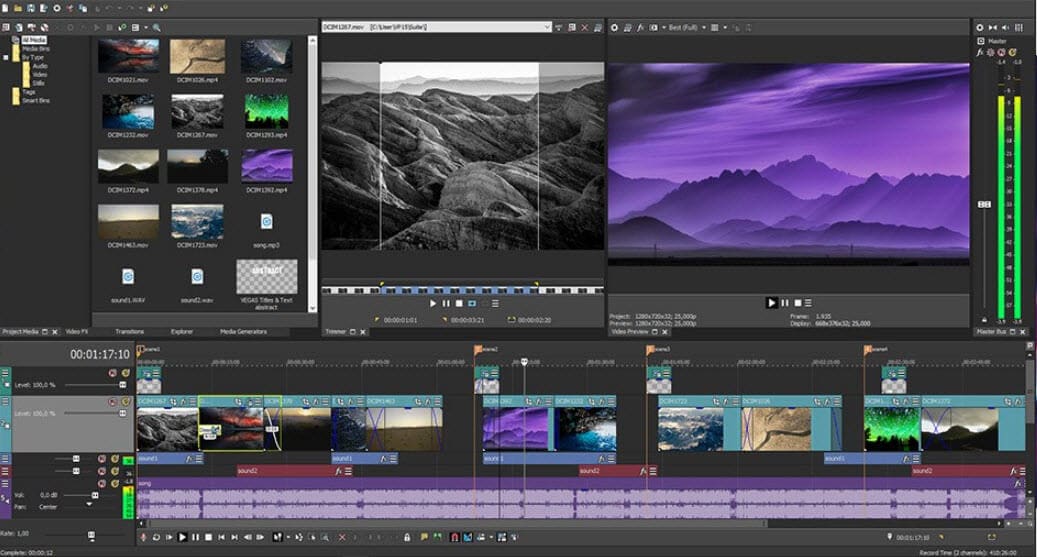
Part 2: Filmmaking Software to Improve Workflow
2. StudioBinder
Keeping up with the production process takes a lot of work, and Studio Binder was specially designed to help you take care of those things more easily. From script breakdowns (which keep everyone in the loop as to what is next in filming) to lists where you keep track of what shots you’ve taken and which you need to take, it has everything you need to keep your entire team on track throughout the entire process of filming.
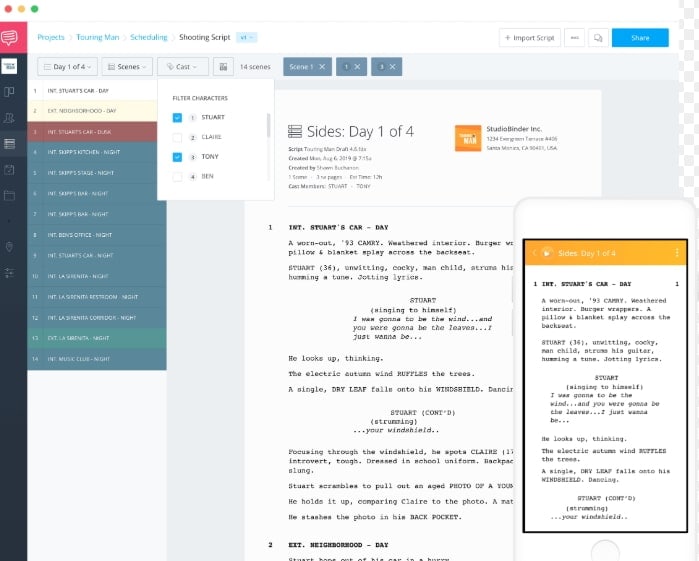
3. Storyboarder
Keeping up with the story and everything around it during the filming process can take a lot of work. That’s why many filmmakers suggest putting together what is known as a storyboard – a rough draft of the storyline, put together in a fashion so that you can follow everything and check it all out properly. Storyboarder is a software package that helps you to visualize everything, check out if the story works, and keep up with your ideas (even if you get distracted during filming).
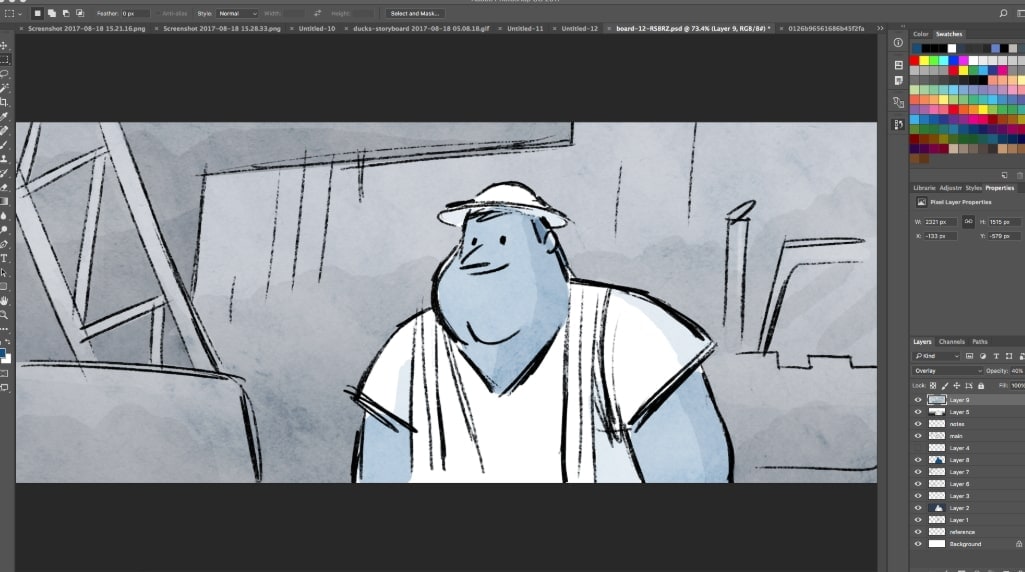
4. Adobe Audition
Sometimes, you need something that is a little more advanced and focused when it comes to putting together the sound mix in a way that is pleasing to the ears. Adobe Audition is one of the most popular options for this, because it has all of the tools necessary so that you can get the perfect balance and fullness of sound in your film. Your sound is just as important as your videography, so picking this up can be really helpful in the long run.

5. Evernote
Organization is absolutely essential when you’re trying to put a film together and, because of that, you’re likely exploring a lot of different options that can help you to stay organized. Evernote is a lovely option and it’s available for computers and for phones/tablets, so you can take it anywhere with you. You can put together task lists, keep notes on what’s going on during the filming process, and more. It’s a really simple program to use and it’s quite easy to import and export info from it.

6. Google Docs
Google Docs is part of the Google Suite, and it’s a smart word processing program that has all of the flexibility of programs like Microsoft Word. One of the biggest differences, however, is the ability to collaborate and work on the same document without the need to send it back and forth via email. Changes are updated in real time, so you can work on a document together, even if you aren’t in the same vicinity.

Conclusion
Do some research on the web and find the options that work best for your team’s budget and for how you plan on working on your films. You can find plenty of low-budget software that can help to make your film look great without breaking the budget you’ve set into place.

Liza Brown
Liza Brown is a writer and a lover of all things video.
Follow @Liza Brown
Liza Brown
Mar 27, 2024• Proven solutions
When you’re an amateur filmmaker, then it’s essential to have affordable options for filmmaking software that can help you to achieve your goals. But, what types of options do you have that are going to fit in your budget? In this article, we’ll give you 7 different options for low-budget filmmaking software.
6 Filmmaking Software You Need to Know
Part 1: Film Editing Software to Edit Videos
1. Filmora Video Editor
Filmora - a video editor which has significantly improved overall performance, making the product faster, and more powerful, and taking the user editing experience to a new level.
It is perfect for helping beginners, and intermediate users create stylish videos by providing an intuitive user interface and built-in effects.
![]()
2. Vegas Pro
Vegas Pro is one of the most well-known budget options out there when it comes to video editing. It actually started out as editing software for audio (podcasts, radio shows, etc.), but then expanded over time. Because of those beginnings, many people have found that it is one of the best options you’ll have available when it comes to audio editing within a film. It’s also very versatile – you don’t need anything but a Windows PC in order to run it.

Part 2: Filmmaking Software to Improve Workflow
2. StudioBinder
Keeping up with the production process takes a lot of work, and Studio Binder was specially designed to help you take care of those things more easily. From script breakdowns (which keep everyone in the loop as to what is next in filming) to lists where you keep track of what shots you’ve taken and which you need to take, it has everything you need to keep your entire team on track throughout the entire process of filming.

3. Storyboarder
Keeping up with the story and everything around it during the filming process can take a lot of work. That’s why many filmmakers suggest putting together what is known as a storyboard – a rough draft of the storyline, put together in a fashion so that you can follow everything and check it all out properly. Storyboarder is a software package that helps you to visualize everything, check out if the story works, and keep up with your ideas (even if you get distracted during filming).

4. Adobe Audition
Sometimes, you need something that is a little more advanced and focused when it comes to putting together the sound mix in a way that is pleasing to the ears. Adobe Audition is one of the most popular options for this, because it has all of the tools necessary so that you can get the perfect balance and fullness of sound in your film. Your sound is just as important as your videography, so picking this up can be really helpful in the long run.

5. Evernote
Organization is absolutely essential when you’re trying to put a film together and, because of that, you’re likely exploring a lot of different options that can help you to stay organized. Evernote is a lovely option and it’s available for computers and for phones/tablets, so you can take it anywhere with you. You can put together task lists, keep notes on what’s going on during the filming process, and more. It’s a really simple program to use and it’s quite easy to import and export info from it.

6. Google Docs
Google Docs is part of the Google Suite, and it’s a smart word processing program that has all of the flexibility of programs like Microsoft Word. One of the biggest differences, however, is the ability to collaborate and work on the same document without the need to send it back and forth via email. Changes are updated in real time, so you can work on a document together, even if you aren’t in the same vicinity.

Conclusion
Do some research on the web and find the options that work best for your team’s budget and for how you plan on working on your films. You can find plenty of low-budget software that can help to make your film look great without breaking the budget you’ve set into place.

Liza Brown
Liza Brown is a writer and a lover of all things video.
Follow @Liza Brown
Liza Brown
Mar 27, 2024• Proven solutions
When you’re an amateur filmmaker, then it’s essential to have affordable options for filmmaking software that can help you to achieve your goals. But, what types of options do you have that are going to fit in your budget? In this article, we’ll give you 7 different options for low-budget filmmaking software.
6 Filmmaking Software You Need to Know
Part 1: Film Editing Software to Edit Videos
1. Filmora Video Editor
Filmora - a video editor which has significantly improved overall performance, making the product faster, and more powerful, and taking the user editing experience to a new level.
It is perfect for helping beginners, and intermediate users create stylish videos by providing an intuitive user interface and built-in effects.
![]()
2. Vegas Pro
Vegas Pro is one of the most well-known budget options out there when it comes to video editing. It actually started out as editing software for audio (podcasts, radio shows, etc.), but then expanded over time. Because of those beginnings, many people have found that it is one of the best options you’ll have available when it comes to audio editing within a film. It’s also very versatile – you don’t need anything but a Windows PC in order to run it.

Part 2: Filmmaking Software to Improve Workflow
2. StudioBinder
Keeping up with the production process takes a lot of work, and Studio Binder was specially designed to help you take care of those things more easily. From script breakdowns (which keep everyone in the loop as to what is next in filming) to lists where you keep track of what shots you’ve taken and which you need to take, it has everything you need to keep your entire team on track throughout the entire process of filming.

3. Storyboarder
Keeping up with the story and everything around it during the filming process can take a lot of work. That’s why many filmmakers suggest putting together what is known as a storyboard – a rough draft of the storyline, put together in a fashion so that you can follow everything and check it all out properly. Storyboarder is a software package that helps you to visualize everything, check out if the story works, and keep up with your ideas (even if you get distracted during filming).

4. Adobe Audition
Sometimes, you need something that is a little more advanced and focused when it comes to putting together the sound mix in a way that is pleasing to the ears. Adobe Audition is one of the most popular options for this, because it has all of the tools necessary so that you can get the perfect balance and fullness of sound in your film. Your sound is just as important as your videography, so picking this up can be really helpful in the long run.

5. Evernote
Organization is absolutely essential when you’re trying to put a film together and, because of that, you’re likely exploring a lot of different options that can help you to stay organized. Evernote is a lovely option and it’s available for computers and for phones/tablets, so you can take it anywhere with you. You can put together task lists, keep notes on what’s going on during the filming process, and more. It’s a really simple program to use and it’s quite easy to import and export info from it.

6. Google Docs
Google Docs is part of the Google Suite, and it’s a smart word processing program that has all of the flexibility of programs like Microsoft Word. One of the biggest differences, however, is the ability to collaborate and work on the same document without the need to send it back and forth via email. Changes are updated in real time, so you can work on a document together, even if you aren’t in the same vicinity.

Conclusion
Do some research on the web and find the options that work best for your team’s budget and for how you plan on working on your films. You can find plenty of low-budget software that can help to make your film look great without breaking the budget you’ve set into place.

Liza Brown
Liza Brown is a writer and a lover of all things video.
Follow @Liza Brown
Liza Brown
Mar 27, 2024• Proven solutions
When you’re an amateur filmmaker, then it’s essential to have affordable options for filmmaking software that can help you to achieve your goals. But, what types of options do you have that are going to fit in your budget? In this article, we’ll give you 7 different options for low-budget filmmaking software.
6 Filmmaking Software You Need to Know
Part 1: Film Editing Software to Edit Videos
1. Filmora Video Editor
Filmora - a video editor which has significantly improved overall performance, making the product faster, and more powerful, and taking the user editing experience to a new level.
It is perfect for helping beginners, and intermediate users create stylish videos by providing an intuitive user interface and built-in effects.
![]()
2. Vegas Pro
Vegas Pro is one of the most well-known budget options out there when it comes to video editing. It actually started out as editing software for audio (podcasts, radio shows, etc.), but then expanded over time. Because of those beginnings, many people have found that it is one of the best options you’ll have available when it comes to audio editing within a film. It’s also very versatile – you don’t need anything but a Windows PC in order to run it.

Part 2: Filmmaking Software to Improve Workflow
2. StudioBinder
Keeping up with the production process takes a lot of work, and Studio Binder was specially designed to help you take care of those things more easily. From script breakdowns (which keep everyone in the loop as to what is next in filming) to lists where you keep track of what shots you’ve taken and which you need to take, it has everything you need to keep your entire team on track throughout the entire process of filming.

3. Storyboarder
Keeping up with the story and everything around it during the filming process can take a lot of work. That’s why many filmmakers suggest putting together what is known as a storyboard – a rough draft of the storyline, put together in a fashion so that you can follow everything and check it all out properly. Storyboarder is a software package that helps you to visualize everything, check out if the story works, and keep up with your ideas (even if you get distracted during filming).

4. Adobe Audition
Sometimes, you need something that is a little more advanced and focused when it comes to putting together the sound mix in a way that is pleasing to the ears. Adobe Audition is one of the most popular options for this, because it has all of the tools necessary so that you can get the perfect balance and fullness of sound in your film. Your sound is just as important as your videography, so picking this up can be really helpful in the long run.

5. Evernote
Organization is absolutely essential when you’re trying to put a film together and, because of that, you’re likely exploring a lot of different options that can help you to stay organized. Evernote is a lovely option and it’s available for computers and for phones/tablets, so you can take it anywhere with you. You can put together task lists, keep notes on what’s going on during the filming process, and more. It’s a really simple program to use and it’s quite easy to import and export info from it.

6. Google Docs
Google Docs is part of the Google Suite, and it’s a smart word processing program that has all of the flexibility of programs like Microsoft Word. One of the biggest differences, however, is the ability to collaborate and work on the same document without the need to send it back and forth via email. Changes are updated in real time, so you can work on a document together, even if you aren’t in the same vicinity.

Conclusion
Do some research on the web and find the options that work best for your team’s budget and for how you plan on working on your films. You can find plenty of low-budget software that can help to make your film look great without breaking the budget you’ve set into place.

Liza Brown
Liza Brown is a writer and a lover of all things video.
Follow @Liza Brown
Cut, Trim, and Edit MP4 Videos with These Free Editors
Top 11 Best Free MP4 Video Cutters

Liza Brown
Mar 27, 2024• Proven solutions
MP4 is a video format mostly used worldwide and it’s also the recommended video format if you want to upload a video to YouTube. There are times when you may need to cut your MP4 videos, for example, to cut out the unwanted parts, or to shorten the duration. The article will list top 11 free MP4 cutters for Windows, Mac and online.
Want a fully-featured product? A commercial product like Wondershare Filmora is a good choice. Besides the video cutting function, this video editing tool also provides various video editing tools. Now you can seamlessly put together video clips, music & text, apply effects to make a professional-looking home movie in minutes. Download and try it out.
If you want to have an online solution, Filmora video trimmer is a free online tool that can help you trim video instantly. You can upload your video from computer and video link with drag-and-drop. It is easy to use with the slider or just input specific start and end times for precise trim. It also supports various importing and exporting video format, including .mp4, .mov, .wemb, .mpeg, .flv. More importantly, the exported video is free of watermark. It is definitely worth a try!
Top 10 Best Free MP4 Video Cutters
2. Avidemux
Avidemux is a free open-source video editing program for Windows, Mac OS X and Linux. It comes with a well selected feature set to get your cutting, filtering and encoding tasks done. It also features a lot of interactive options and step by step guide for using this tool is there. Hence, using this tool is quite easy.

Pros:
- Lightweight and fairly simple;
- Useful video filters.
Cons:
- Outdated interface;
- May drop frames in certain formats;
- Can be complicated for beginning users.
3. Lightworks
This is one of the most advanced video editing or cutter tool. It features seamless options though a little complicated for the novice users. However, it is the coolest tool for serving professional purposes. It can handle large file sizes with ease.

Pros:
- Various video editing options;
- High video quality.
Cons:
- It crashes occasionally;
- Requires a long learning curve.
4. VSDC Free Video Editor
It’s a free video editing program which supports various video formats include MP4, AVI, MKV, MPG, WMV, FLV and more. It provides various video filters, transitions, audio effects as well as drawing and selection tools. With it, you can easily cut your MP4 files into different pieces. When the editing done, you can also select the optimized save outputs for a variety of devices, including smart phones and gaming consoles.

Pros:
- Provides various useful filters;
- Different output options.
Cons:
- Computer resources (CPU and RAM) are required at a high level.
5. iMovie
The second position of the list will be clinched by iMovie as it is quite similar the Windows Movie Maker, compatible for MAC OS X only. In fact, this software offers a few amazing features which are absent in Windows Movie Maker. With it, you can easily cut video into pieces and edit any part of the video as you like. Truly a powerful and effective tool! File saving and export options are particularly praiseworthy.

Pros:
- Easy-to-use and efficient;
- Useful video editing functions.
Cons:
- The supported video formats are limited.
6. Free Video Cutter
Freemake video Cutter does exactly what its name suggests, and that is cut video. As well as MP4 it can deal with several other video formats, it uses a nice easy to follow interface and is a nice compact package that does the job well.

One of the easiest to use, a simple interface and good performance.
7. Freemake Video Converter
Whilst, as the name suggests, this package was designed for format conversion, it includes a wealth of other abilities, one of which is video cutting, it can also rejoin and merge clips too. As a video converter, it has the largest range of format compatibility in the list and can even burn your finished videos to DVD or Blu-ray for you. The cutting feature is nicely implemented into a clear interface and should be straightforward for anyone to use.

An easy to use interface and a comprehensive feature set far beyond just cutting make this a great general video utility package.
8. Movica
This package uses other open source scripting files as the mechanics of doing its job, and is in essence a user interface for those systems. That takes nothing away from it though, the tools it uses are very effective, but in their native form not something most people could take advantage of. In addition to MP4 there are several other video formats available as well as both .wma and .mp3 audio files.
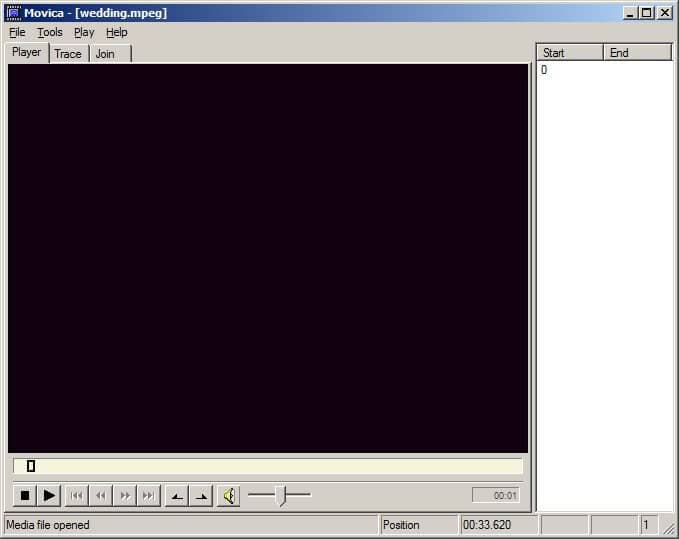
A simple interface and a more technical outlook than many, but it works well.
9. Virtualdub
A fairly comprehensive editing package, VirtualDub has a nice selection of cutting tools enabling accurate cuts and edits with ease, covering the MP4 format as well as several others, it is a useful tool for those looking for additional features beyond just cutting. Due to the lengthy feature set the interface is a little cluttered and for those that want nothing but a cutter, is perhaps overkill, however, it does the job very well and for many presents a useful selection of video tools.
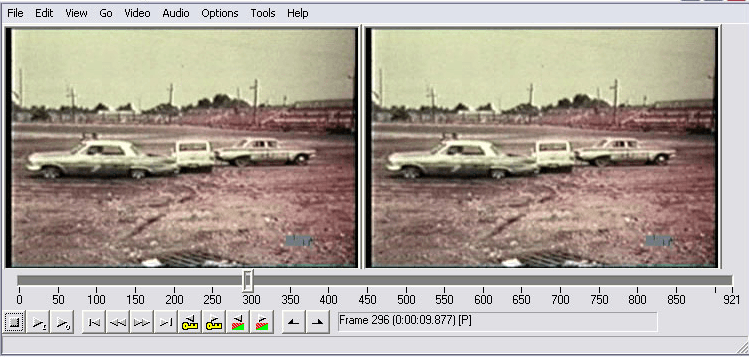
With plenty of video tools in addition to cutting, VirtualDub presents an attractive, video toolbox for the enthusiast.
10. Online Video Cutter
Our final offering is a slightly different take on the video cutter. This is an online offering that requires no downloads or installation, you simply go to the website, upload your video or select a video on the web, cut the video and save the output. It is very simple, although there is the obvious issue with larger files of upload and download time, but for many applications is perhaps the ideal solution.

Without the need to install anything, and with a very simple interface, for smaller files is perhaps the perfect solution.

Liza Brown
Liza Brown is a writer and a lover of all things video.
Follow @Liza Brown
Liza Brown
Mar 27, 2024• Proven solutions
MP4 is a video format mostly used worldwide and it’s also the recommended video format if you want to upload a video to YouTube. There are times when you may need to cut your MP4 videos, for example, to cut out the unwanted parts, or to shorten the duration. The article will list top 11 free MP4 cutters for Windows, Mac and online.
Want a fully-featured product? A commercial product like Wondershare Filmora is a good choice. Besides the video cutting function, this video editing tool also provides various video editing tools. Now you can seamlessly put together video clips, music & text, apply effects to make a professional-looking home movie in minutes. Download and try it out.
If you want to have an online solution, Filmora video trimmer is a free online tool that can help you trim video instantly. You can upload your video from computer and video link with drag-and-drop. It is easy to use with the slider or just input specific start and end times for precise trim. It also supports various importing and exporting video format, including .mp4, .mov, .wemb, .mpeg, .flv. More importantly, the exported video is free of watermark. It is definitely worth a try!
Top 10 Best Free MP4 Video Cutters
2. Avidemux
Avidemux is a free open-source video editing program for Windows, Mac OS X and Linux. It comes with a well selected feature set to get your cutting, filtering and encoding tasks done. It also features a lot of interactive options and step by step guide for using this tool is there. Hence, using this tool is quite easy.

Pros:
- Lightweight and fairly simple;
- Useful video filters.
Cons:
- Outdated interface;
- May drop frames in certain formats;
- Can be complicated for beginning users.
3. Lightworks
This is one of the most advanced video editing or cutter tool. It features seamless options though a little complicated for the novice users. However, it is the coolest tool for serving professional purposes. It can handle large file sizes with ease.

Pros:
- Various video editing options;
- High video quality.
Cons:
- It crashes occasionally;
- Requires a long learning curve.
4. VSDC Free Video Editor
It’s a free video editing program which supports various video formats include MP4, AVI, MKV, MPG, WMV, FLV and more. It provides various video filters, transitions, audio effects as well as drawing and selection tools. With it, you can easily cut your MP4 files into different pieces. When the editing done, you can also select the optimized save outputs for a variety of devices, including smart phones and gaming consoles.

Pros:
- Provides various useful filters;
- Different output options.
Cons:
- Computer resources (CPU and RAM) are required at a high level.
5. iMovie
The second position of the list will be clinched by iMovie as it is quite similar the Windows Movie Maker, compatible for MAC OS X only. In fact, this software offers a few amazing features which are absent in Windows Movie Maker. With it, you can easily cut video into pieces and edit any part of the video as you like. Truly a powerful and effective tool! File saving and export options are particularly praiseworthy.

Pros:
- Easy-to-use and efficient;
- Useful video editing functions.
Cons:
- The supported video formats are limited.
6. Free Video Cutter
Freemake video Cutter does exactly what its name suggests, and that is cut video. As well as MP4 it can deal with several other video formats, it uses a nice easy to follow interface and is a nice compact package that does the job well.

One of the easiest to use, a simple interface and good performance.
7. Freemake Video Converter
Whilst, as the name suggests, this package was designed for format conversion, it includes a wealth of other abilities, one of which is video cutting, it can also rejoin and merge clips too. As a video converter, it has the largest range of format compatibility in the list and can even burn your finished videos to DVD or Blu-ray for you. The cutting feature is nicely implemented into a clear interface and should be straightforward for anyone to use.

An easy to use interface and a comprehensive feature set far beyond just cutting make this a great general video utility package.
8. Movica
This package uses other open source scripting files as the mechanics of doing its job, and is in essence a user interface for those systems. That takes nothing away from it though, the tools it uses are very effective, but in their native form not something most people could take advantage of. In addition to MP4 there are several other video formats available as well as both .wma and .mp3 audio files.

A simple interface and a more technical outlook than many, but it works well.
9. Virtualdub
A fairly comprehensive editing package, VirtualDub has a nice selection of cutting tools enabling accurate cuts and edits with ease, covering the MP4 format as well as several others, it is a useful tool for those looking for additional features beyond just cutting. Due to the lengthy feature set the interface is a little cluttered and for those that want nothing but a cutter, is perhaps overkill, however, it does the job very well and for many presents a useful selection of video tools.

With plenty of video tools in addition to cutting, VirtualDub presents an attractive, video toolbox for the enthusiast.
10. Online Video Cutter
Our final offering is a slightly different take on the video cutter. This is an online offering that requires no downloads or installation, you simply go to the website, upload your video or select a video on the web, cut the video and save the output. It is very simple, although there is the obvious issue with larger files of upload and download time, but for many applications is perhaps the ideal solution.

Without the need to install anything, and with a very simple interface, for smaller files is perhaps the perfect solution.

Liza Brown
Liza Brown is a writer and a lover of all things video.
Follow @Liza Brown
Liza Brown
Mar 27, 2024• Proven solutions
MP4 is a video format mostly used worldwide and it’s also the recommended video format if you want to upload a video to YouTube. There are times when you may need to cut your MP4 videos, for example, to cut out the unwanted parts, or to shorten the duration. The article will list top 11 free MP4 cutters for Windows, Mac and online.
Want a fully-featured product? A commercial product like Wondershare Filmora is a good choice. Besides the video cutting function, this video editing tool also provides various video editing tools. Now you can seamlessly put together video clips, music & text, apply effects to make a professional-looking home movie in minutes. Download and try it out.
If you want to have an online solution, Filmora video trimmer is a free online tool that can help you trim video instantly. You can upload your video from computer and video link with drag-and-drop. It is easy to use with the slider or just input specific start and end times for precise trim. It also supports various importing and exporting video format, including .mp4, .mov, .wemb, .mpeg, .flv. More importantly, the exported video is free of watermark. It is definitely worth a try!
Top 10 Best Free MP4 Video Cutters
2. Avidemux
Avidemux is a free open-source video editing program for Windows, Mac OS X and Linux. It comes with a well selected feature set to get your cutting, filtering and encoding tasks done. It also features a lot of interactive options and step by step guide for using this tool is there. Hence, using this tool is quite easy.

Pros:
- Lightweight and fairly simple;
- Useful video filters.
Cons:
- Outdated interface;
- May drop frames in certain formats;
- Can be complicated for beginning users.
3. Lightworks
This is one of the most advanced video editing or cutter tool. It features seamless options though a little complicated for the novice users. However, it is the coolest tool for serving professional purposes. It can handle large file sizes with ease.

Pros:
- Various video editing options;
- High video quality.
Cons:
- It crashes occasionally;
- Requires a long learning curve.
4. VSDC Free Video Editor
It’s a free video editing program which supports various video formats include MP4, AVI, MKV, MPG, WMV, FLV and more. It provides various video filters, transitions, audio effects as well as drawing and selection tools. With it, you can easily cut your MP4 files into different pieces. When the editing done, you can also select the optimized save outputs for a variety of devices, including smart phones and gaming consoles.

Pros:
- Provides various useful filters;
- Different output options.
Cons:
- Computer resources (CPU and RAM) are required at a high level.
5. iMovie
The second position of the list will be clinched by iMovie as it is quite similar the Windows Movie Maker, compatible for MAC OS X only. In fact, this software offers a few amazing features which are absent in Windows Movie Maker. With it, you can easily cut video into pieces and edit any part of the video as you like. Truly a powerful and effective tool! File saving and export options are particularly praiseworthy.

Pros:
- Easy-to-use and efficient;
- Useful video editing functions.
Cons:
- The supported video formats are limited.
6. Free Video Cutter
Freemake video Cutter does exactly what its name suggests, and that is cut video. As well as MP4 it can deal with several other video formats, it uses a nice easy to follow interface and is a nice compact package that does the job well.

One of the easiest to use, a simple interface and good performance.
7. Freemake Video Converter
Whilst, as the name suggests, this package was designed for format conversion, it includes a wealth of other abilities, one of which is video cutting, it can also rejoin and merge clips too. As a video converter, it has the largest range of format compatibility in the list and can even burn your finished videos to DVD or Blu-ray for you. The cutting feature is nicely implemented into a clear interface and should be straightforward for anyone to use.

An easy to use interface and a comprehensive feature set far beyond just cutting make this a great general video utility package.
8. Movica
This package uses other open source scripting files as the mechanics of doing its job, and is in essence a user interface for those systems. That takes nothing away from it though, the tools it uses are very effective, but in their native form not something most people could take advantage of. In addition to MP4 there are several other video formats available as well as both .wma and .mp3 audio files.

A simple interface and a more technical outlook than many, but it works well.
9. Virtualdub
A fairly comprehensive editing package, VirtualDub has a nice selection of cutting tools enabling accurate cuts and edits with ease, covering the MP4 format as well as several others, it is a useful tool for those looking for additional features beyond just cutting. Due to the lengthy feature set the interface is a little cluttered and for those that want nothing but a cutter, is perhaps overkill, however, it does the job very well and for many presents a useful selection of video tools.

With plenty of video tools in addition to cutting, VirtualDub presents an attractive, video toolbox for the enthusiast.
10. Online Video Cutter
Our final offering is a slightly different take on the video cutter. This is an online offering that requires no downloads or installation, you simply go to the website, upload your video or select a video on the web, cut the video and save the output. It is very simple, although there is the obvious issue with larger files of upload and download time, but for many applications is perhaps the ideal solution.

Without the need to install anything, and with a very simple interface, for smaller files is perhaps the perfect solution.

Liza Brown
Liza Brown is a writer and a lover of all things video.
Follow @Liza Brown
Liza Brown
Mar 27, 2024• Proven solutions
MP4 is a video format mostly used worldwide and it’s also the recommended video format if you want to upload a video to YouTube. There are times when you may need to cut your MP4 videos, for example, to cut out the unwanted parts, or to shorten the duration. The article will list top 11 free MP4 cutters for Windows, Mac and online.
Want a fully-featured product? A commercial product like Wondershare Filmora is a good choice. Besides the video cutting function, this video editing tool also provides various video editing tools. Now you can seamlessly put together video clips, music & text, apply effects to make a professional-looking home movie in minutes. Download and try it out.
If you want to have an online solution, Filmora video trimmer is a free online tool that can help you trim video instantly. You can upload your video from computer and video link with drag-and-drop. It is easy to use with the slider or just input specific start and end times for precise trim. It also supports various importing and exporting video format, including .mp4, .mov, .wemb, .mpeg, .flv. More importantly, the exported video is free of watermark. It is definitely worth a try!
Top 10 Best Free MP4 Video Cutters
2. Avidemux
Avidemux is a free open-source video editing program for Windows, Mac OS X and Linux. It comes with a well selected feature set to get your cutting, filtering and encoding tasks done. It also features a lot of interactive options and step by step guide for using this tool is there. Hence, using this tool is quite easy.

Pros:
- Lightweight and fairly simple;
- Useful video filters.
Cons:
- Outdated interface;
- May drop frames in certain formats;
- Can be complicated for beginning users.
3. Lightworks
This is one of the most advanced video editing or cutter tool. It features seamless options though a little complicated for the novice users. However, it is the coolest tool for serving professional purposes. It can handle large file sizes with ease.

Pros:
- Various video editing options;
- High video quality.
Cons:
- It crashes occasionally;
- Requires a long learning curve.
4. VSDC Free Video Editor
It’s a free video editing program which supports various video formats include MP4, AVI, MKV, MPG, WMV, FLV and more. It provides various video filters, transitions, audio effects as well as drawing and selection tools. With it, you can easily cut your MP4 files into different pieces. When the editing done, you can also select the optimized save outputs for a variety of devices, including smart phones and gaming consoles.

Pros:
- Provides various useful filters;
- Different output options.
Cons:
- Computer resources (CPU and RAM) are required at a high level.
5. iMovie
The second position of the list will be clinched by iMovie as it is quite similar the Windows Movie Maker, compatible for MAC OS X only. In fact, this software offers a few amazing features which are absent in Windows Movie Maker. With it, you can easily cut video into pieces and edit any part of the video as you like. Truly a powerful and effective tool! File saving and export options are particularly praiseworthy.

Pros:
- Easy-to-use and efficient;
- Useful video editing functions.
Cons:
- The supported video formats are limited.
6. Free Video Cutter
Freemake video Cutter does exactly what its name suggests, and that is cut video. As well as MP4 it can deal with several other video formats, it uses a nice easy to follow interface and is a nice compact package that does the job well.

One of the easiest to use, a simple interface and good performance.
7. Freemake Video Converter
Whilst, as the name suggests, this package was designed for format conversion, it includes a wealth of other abilities, one of which is video cutting, it can also rejoin and merge clips too. As a video converter, it has the largest range of format compatibility in the list and can even burn your finished videos to DVD or Blu-ray for you. The cutting feature is nicely implemented into a clear interface and should be straightforward for anyone to use.

An easy to use interface and a comprehensive feature set far beyond just cutting make this a great general video utility package.
8. Movica
This package uses other open source scripting files as the mechanics of doing its job, and is in essence a user interface for those systems. That takes nothing away from it though, the tools it uses are very effective, but in their native form not something most people could take advantage of. In addition to MP4 there are several other video formats available as well as both .wma and .mp3 audio files.

A simple interface and a more technical outlook than many, but it works well.
9. Virtualdub
A fairly comprehensive editing package, VirtualDub has a nice selection of cutting tools enabling accurate cuts and edits with ease, covering the MP4 format as well as several others, it is a useful tool for those looking for additional features beyond just cutting. Due to the lengthy feature set the interface is a little cluttered and for those that want nothing but a cutter, is perhaps overkill, however, it does the job very well and for many presents a useful selection of video tools.

With plenty of video tools in addition to cutting, VirtualDub presents an attractive, video toolbox for the enthusiast.
10. Online Video Cutter
Our final offering is a slightly different take on the video cutter. This is an online offering that requires no downloads or installation, you simply go to the website, upload your video or select a video on the web, cut the video and save the output. It is very simple, although there is the obvious issue with larger files of upload and download time, but for many applications is perhaps the ideal solution.

Without the need to install anything, and with a very simple interface, for smaller files is perhaps the perfect solution.

Liza Brown
Liza Brown is a writer and a lover of all things video.
Follow @Liza Brown
Also read:
- Updated In 2024, How to Create Engaging LinkedIn Video Thumbnails A Step-by-Step Guide
- Updated 2024 Approved Unlock the Power of Screen Recording A Filmora Scrn Tutorial
- New In 2024, VHS Chic Best Mobile Apps for Achieving a Retro Aesthetic in Your Videos
- New In 2024, MP4 Made Easy 10 Best WebM to MP4 Conversion Tools
- Updated 2024 Approved The Ultimate Guide to Downloading Instagram Soundtracks
- In 2024, The Aspect Ratio Handbook A Step-by-Step Guide to Social Media Visuals
- Updated In 2024, Mobile Reaction Video Studios Top iOS and Android Apps
- Updated The Ultimate Aspect Ratio Calculator Resource Tips and Tricks
- Updated Lumafusion for macOS Download and Explore Top Alternatives for 2024
- Updated Stop Motion Like a Pro Expert Tips and Techniques for Instagram Success for 2024
- New In 2024, Top-Rated Video Montage Makers
- New 2024 Approved Video Trimming 101 A Beginners Guide to Using Kapwing Editor
- Updated In 2024, Optimize Your LinkedIn Videos The Best Aspect Ratios for Engagement
- The Ultimate List of Free Online Tools to Blur Photo Backgrounds for 2024
- Updated Facebook Video to MP3 Top Online Conversion Tools for 2024
- Updated Aspect Ratio Made Easy Top Online Calculators for 2024
- Updated In 2024, OS X Mavericks MP4 Editing Software Top Picks
- Updated In 2024, Measure and Modify Image Size
- New In 2024, Create Stunning Time Lapses with Final Cut Pro A Beginners Guide
- Updated Preserve the Original Sound How to Convert Video to MP3 without Quality Loss for 2024
- New 2024 Approved Unleash the Power of Slow Motion Best Video Editing Tools
- Updated Mac Alternatives to VSDC Best Video Editing Software Options for 2024
- Must-Have 3D Video Editing Software for Creators for 2024
- Updated From Camera to Computer Editing Sony Camcorder Videos with Ease for 2024
- New Mobile Video Magic Top Apps for Animated Text Overlays for 2024
- New In 2024, Transform Your GoPro Clips A Comprehensive Mac Editing Tutorial
- Video Editing Made Easy Top Free Software for 32-Bit Windows for 2024
- Updated 2024 Approved Elevate Your Game Top 10 Online Gaming Intro Generators
- In 2024, 3 Ways to Unlock Your Apple iPhone 11 for Free
- In 2024, Best Anti Tracker Software For Xiaomi Redmi Note 12 Pro+ 5G | Dr.fone
- In 2024, 10 Best Fake GPS Location Spoofers for Google Pixel 7a | Dr.fone
- Fix the Error of Unfortunately the Process.com.android.phone Has Stopped on Lenovo ThinkPhone | Dr.fone
- How to Make a Talking AI Avatar From Photos Easy Guide
- 4 Things You Must Know About iPhone 13 Pro Activation Lock
- How to Meizu Get Deleted Phone Number Back with Ease and Safety
- How to Change/Fake Your Poco F5 Pro 5G Location on Viber | Dr.fone
- Updated In 2024, Twitter Video Aspect Ratio Made Easy Quick Reference Guide
- 3 Facts You Need to Know about Screen Mirroring OnePlus Nord N30 SE | Dr.fone
- All About Factory Reset, What Is It and What It Does to Your Samsung Galaxy A14 5G? | Dr.fone
- The Best Android Unlock Software For Vivo X100 Device Top 5 Picks to Remove Android Locks
- Title: New No-Watermark Video Merger Tools Our Top 7 Picks
- Author: MdadeLe
- Created at : 2024-05-19 08:26:17
- Updated at : 2024-05-20 08:26:17
- Link: https://smart-video-editing.techidaily.com/new-no-watermark-video-merger-tools-our-top-7-picks/
- License: This work is licensed under CC BY-NC-SA 4.0.



